Barrenjoey High School's 50th Year Celebrations: the golden ball celebration
Barrenjoey High School is turning 50 this year.
The school and school community have been holding a number of events including the Colour Run / Obstacle Course of March, The Barrenjoey Night Market in June, and on the Saturday the 29th of September – The Golden Ball!
All Ex-students, staff, parents and members of the Barrenjoey community are invited to celebrate. There will be a Three-course meal, the event will be fully licensed, with live bands, a memorabilia exhibition, and much more. Dress: Women: Elegant Men: Dashing!
Tickets are available until September 20th at www.trybooking.com/book/event-388728
How did a High School for this end of the peninsula eventuate?
Sir Harold Wyndham CBE (27 June 1903 – 22 April 1988) was Director-General of Education in New South Wales between 1952 and 1968. In 1954 Dr. Wyndham was appointed to chair a committee tasked to completely review the Secondary education system in New South Wales and make recommendations for improvements. The committee's report, popularly referred to as "The Wyndham Report", was presented to the Minister in October 1957 and gave rise to the Public Education Act of 1961 which was brought into effect in 1962. Key amongst the changes was the objective of presenting all students with the opportunity to experience a wide range of subjects, including visual arts, industrial arts, music and drama, and a wide range of languages. The Five-year Secondary School system was abandoned in favour of adding another year to the course, with major state-wide external examinations at the end of the Tenth (School Certificate) and the twelfth (Higher School Certificate) year of schooling.
What this really meant was "The Wyndham Scheme" created changes to the curriculum which had a more student-centred approach.
When Dr Wyndham was appointed as Director-General of Education there were 455,000 students in the NSW Education system, of whom 100,000 were in Secondary schools. By 1968 there were over 244,000 students in secondary school of whom 64% could be expected to complete the then brand new Higher School Certificate.
The NSW Government Architect’s Branch met this demand by innovating new designs for high schools which could be built quickly and cheaply. These included the so-called ‘doughnut schools’, designed by Michael Dysart.
‘The Dysart schools from this period were innovative in two main ways. As with leading European and North American architects who designed innovative schools in the period such as Arne Jacobsen, Hans Scharoun, Denys Lasdun and Caudill Rowlett Scott (CRS), Dysart moved away from simple linear blocks or finger planned schools, which were typical in the postwar years. In their place he employed a series of square doughnuts in a sort of pinwheel configuration around a large central space. He usually placed a rostrum and bell tower – which sometimes also doubled as an incinerator – in that central space, which could then be used as an all-of-school gathering area. The scheme did away with indoor hallways and replaced them with covered walkways and cloisters. The second innovation was a novel construction process which enabled the erection of a structurally independent roof very early in the process. This allowed work to go on regardless of weather and proved to be a significant efficiency. By these means Dysart provided a new sense of refuge and place definition in the school environment while also devising an efficient system for delivering school buildings. While there was a general move towards ‘demonumentalizing’ school buildings in the post-war decades, the Dysart-designed schools introduced a different set of spatial relationships, one which recalled the deeper traditions of communities of learning.’ - First published in Architecture Bulletin Nov/Dec 2012.

Some of the first Dysart schools were built at Turramurra, Ryde and Pendle Hill. One Dysart doughnut school was also built in Pittwater and originally referred to as Avalon High School during Tender/build stages. We now know this school as Barrenjoey High School.
The first intake was in 1968.
The style of the structure built for the students is reflected in the school's inner spirit and place in the community as another ‘heart’ if you like. A sense of community, a progressive outlook from the first intake to the subjects students may choose today or the way current issues faced by students, parents and teachers are addressed is a many gathered as one equation. That inner quality will soon produce another extension in building form as the Barrenjoey Community Performance is realised as this too will showcase individual voices within the school and within the community and their interconnections.
Barrenjoey promotes a vision of providing a school experience where Respect, Effort and Challenge are highly valued - in fact that's the school's motto. Students respect the subjects they study, the content, teachers, environment and themselves, where effort is expected, valued, recognised and celebrated and where students are enabled to realise the worth in challenging themselves to ‘be the best they can be’.
Although the school has a vast number of notable alumni across Arts, Science and Sports and every other field of human endeavour, it is the simply great human beings with great attitude that emerge from this school that best serve as its 'dream come true'. These are individuals that stand upright, care about the place around them, the people in it and are aware of how we are all interlinked – connected.
NOTIFICATION OF RESUMPTION OF LAND UNDER
THE PUBLIC WORKS ACT, 1912, AS AMENDED
IT is hereby notified and declared by His Excellency the Governor, acting with the advice of the Executive Council, that so much of the land described in the Schedule hereto as is Crown land is hereby appropriated, and so much of the said land as is private property is hereby resumed, under the Public Works Act, 1912, as amended, for the following public purpose, namely, a High School at AVALON, and that the said land is vested in the Minister for Education as Constructing Authority on behalf of Her Majesty the Queen.
Dated this twenty-second day of June, one thousand nine hundred and sixty-six.
A. R. CUTLER, Governor. By His Excellency's Command,
C. B. CUTLER, Minister for Education.
The Schedule
All that piece or parcel of land situate in the Shire of Warringah, parish of Narrabeen and county of Cumberland, being lots 1 and 2, section 4, Deposited Plan 13,811, and being also the whole of the land comprised in Certificates of Title, volume 9,994, folios 134 and 135,—having an area of 2 roods 11 perches or thereabouts and said to be in the possession of Avalon Developments Pty Ltd and Northbridge Constructions Pty Ltd. NOTIFICATION OF RESUMPTION OF LAND UNDER THE PUBLIC WORKS ACT, 1912, AS AMENDED (1966, July 8). Government Gazette of the State of New South Wales (Sydney, NSW : 1901 - 2001), p. 2703. Retrieved from http://nla.gov.au/nla.news-article220022810
Department of Public Works—Tenders for Works
TENDERS will be received up to 2 p.m. on the dates specified for the undermentioned works. Envelopes containing tenders must be addressed to the President, Tender Board, Department of Public Works, Box 44, G.P.O., Sydney, and have legibly endorsed upon the face thereof the name of the work for which the tender is submitted. The Government does not bind itself to accept the lowest or any tender. Specifications and plans for all works may be seen in Contractor's Room, Department of Public Works, Sydney, in addition to the other places mentioned. Plans and specifications for works other than architectural works and building engineering services and excluding also those plans and specifications issued in respect of quotations and minor contracts, issued from the Postal and Contractor's Room of the Department, must be purchased at the rates of 50c for the plan with a maximum of $8.40 and $1 for the specification. Where the total cost of the plans and specifications is more than $1 and provided the plans and specifications are returned to the Department prior to the closing date in good order and condition a refund of the purchase money may be made:
Avalon High School—Stage I. (Bills of Quantity, $8 each.) Avalon High School—Electrical Services. (Sub-contract.) Department of Public Works—Tenders for Works (1966, November 4). Government Gazette of the State of New South Wales (Sydney, NSW : 1901 - 2001), p. 4524. Retrieved from http://nla.gov.au/nla.news-article220020370
NOTIFICATION OF RESUMPTION OF LAND UNDER
THE PUBLIC WORKS ACT, 1912, AS AMENDED
IT is hereby notified and declared by His Excellency the Governor, acting with the advice of the Executive Council, that so much of the land described in the Schedule hereto as is crown land is hereby appropriated, and so much of the said land as is private property is hereby resumed, under the Public Works Act, 1912, as amended, for the following public purpose, namely a High School at AVALON, and that the said land is vested in the Minister for Education as Constructing Authority on behalf of Her Majesty the Queen.
Dated this sixth day of December, one thousand nine hundred and sixty-seven.
A. R. CUTLER, Governor. By His Excellency's Command,
C. B. CUTLER, Minister for Education.
The Schedule
All that piece or parcel of land situated in the Shire of Warringah, Parish of Narrabeen and County of Cumberland, being lot 3, section 4, Deposited Plan 13811, containing an area of 1 rood 0 ¾ perches or thereabouts and said to be in the possession of the Department of Education.
NOTIFICATION OF RESUMPTION OF LAND UNDER THE PUBLIC WORKS ACT, 1912, AS AMENDED (1967, December 22). Government Gazette of the State of New South Wales (Sydney, NSW : 1901 - 2001), p. 4846. Retrieved from http://nla.gov.au/nla.news-article220059551
Kulka : Barrenjoey High School magazine – 1971 Joey : Barrenjoey High School magazine - 1978
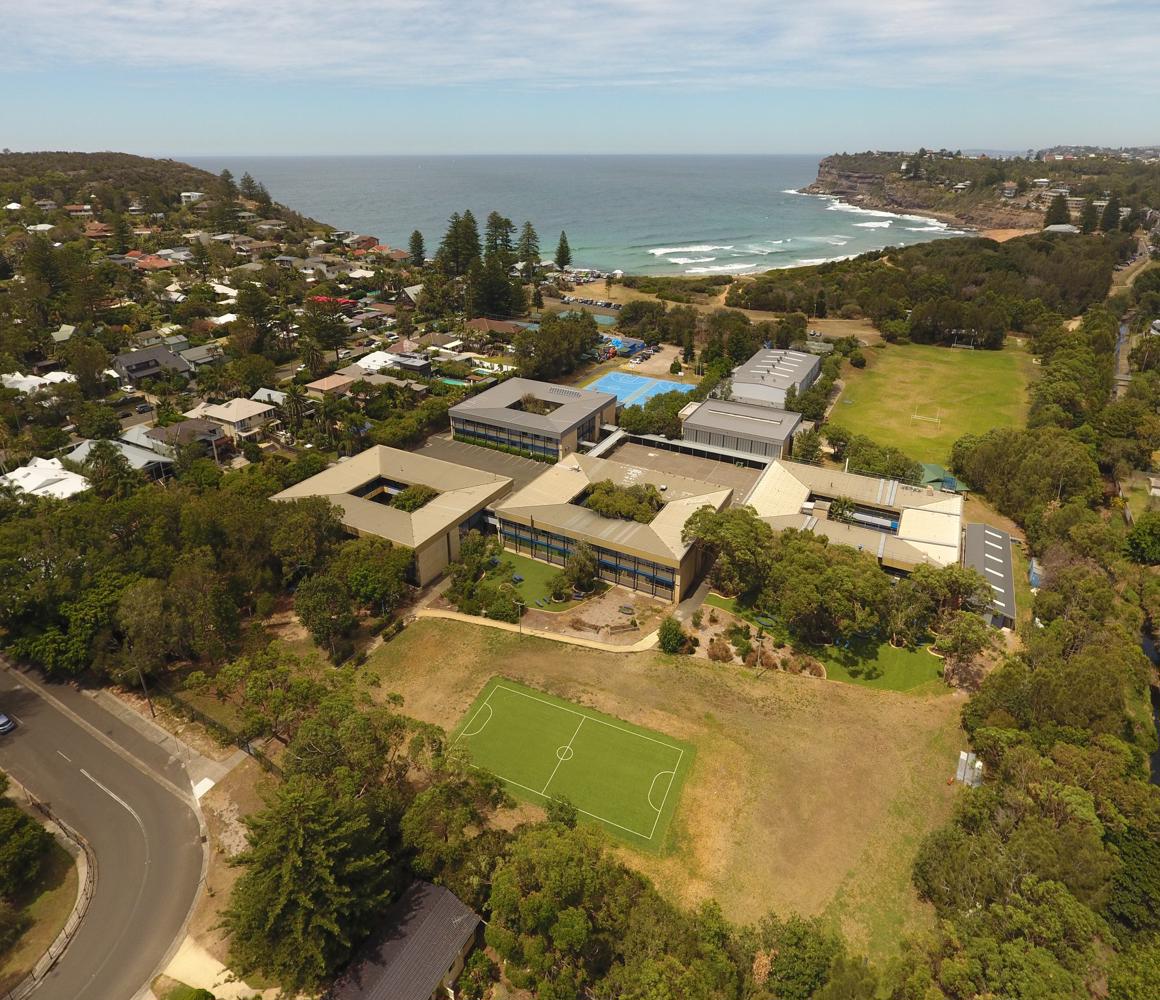
Aerial/drone photo of BHS in 2017 - courtesy BHS P & C Committee
The Barrenjoey High School that opened in 1968 was a little under a hundred years prior to that a school of a similar name commenced atop the headland so many BHS students love.
A few notes to get you in a golden mood - no, there will not be an exam on this - enjoy !
The Barrenjoey School: 1872 To 1894
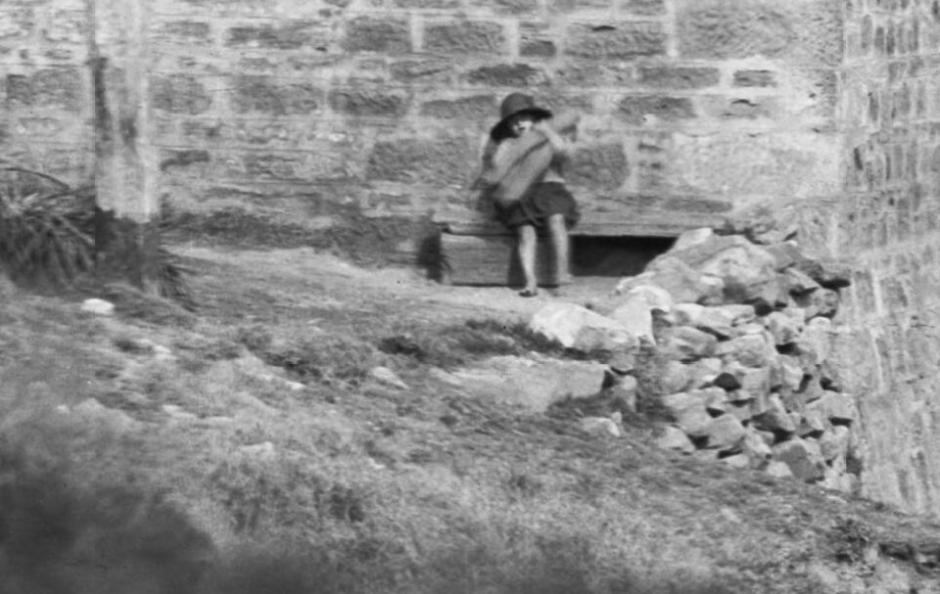
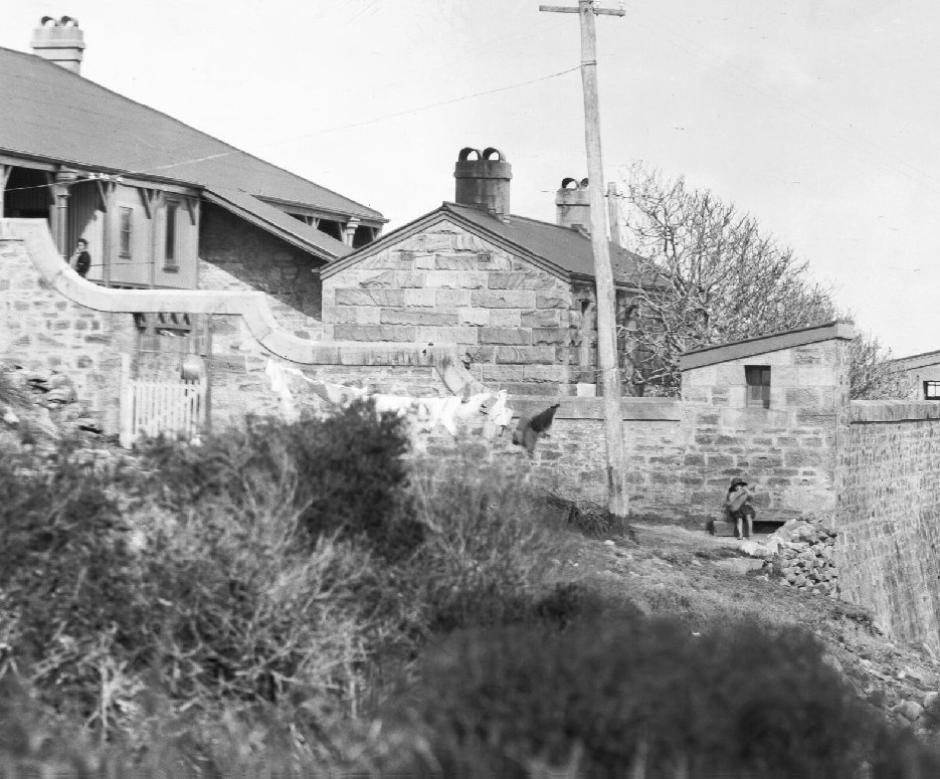
EB Studios (Sydney, N.S.W.). 1917, Panorama of Palm Beach, New South Wales, 14 , PIC P865/6/1 LOC Nitrate store, (zoomable at http://nla.gov.au/nla.obj-162567120 ) and sections from – courtesy National Library of Australia
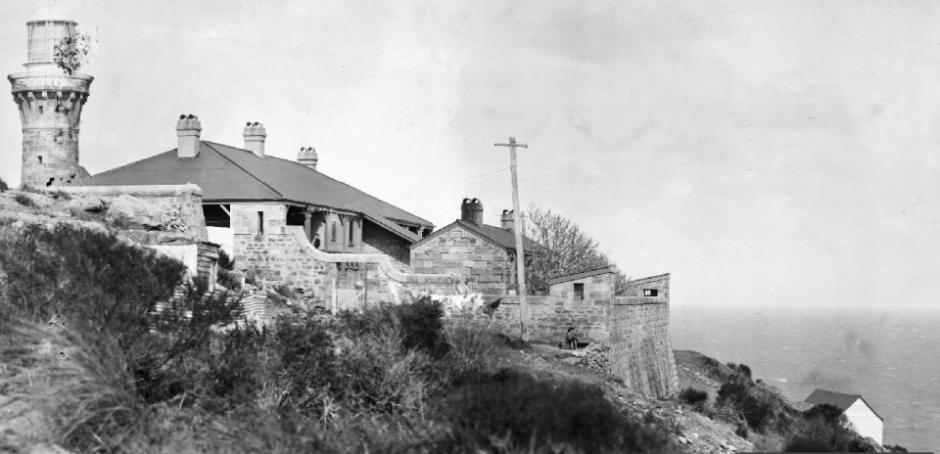

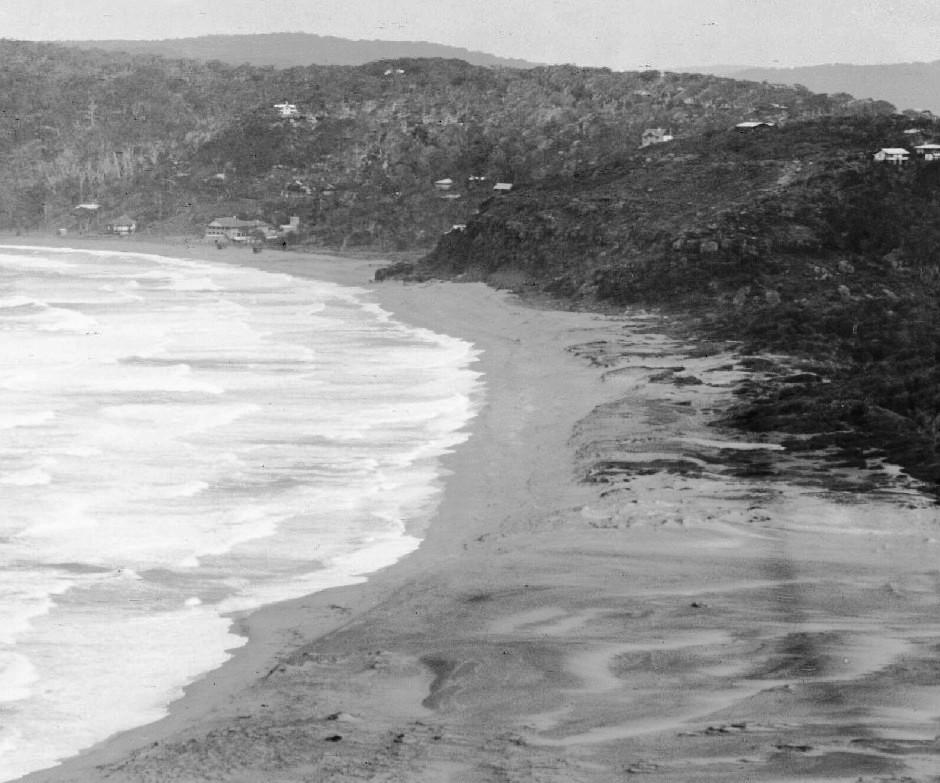
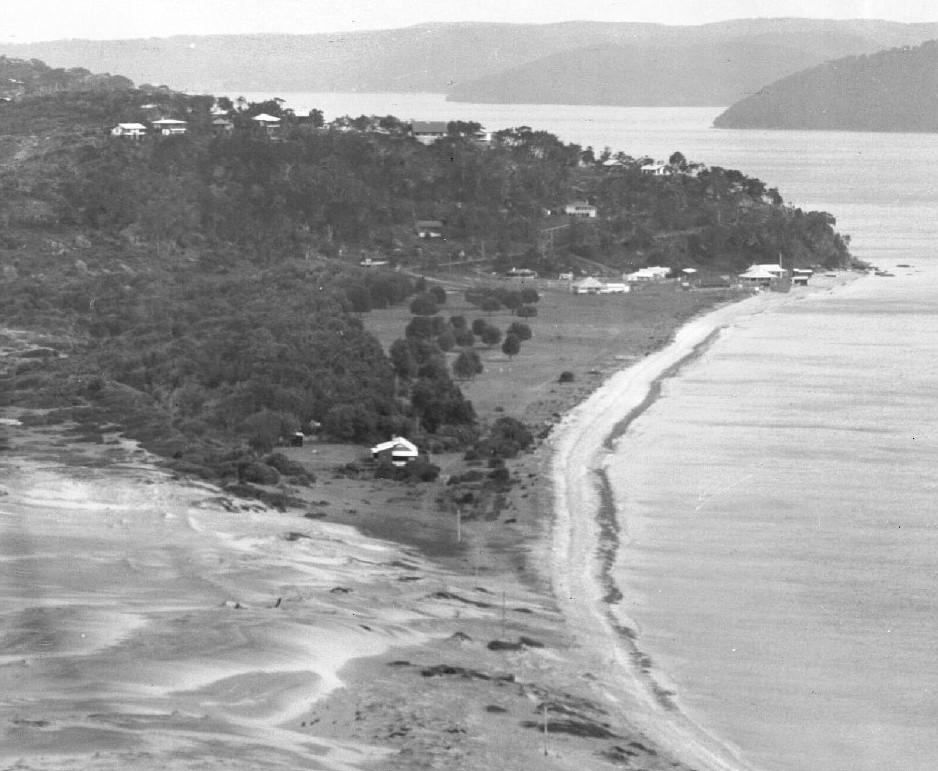
The Council of Education was established from 1 January 1867 under the Public Schools Act of 1866 to assume responsibility for the centralised administration of government schools in New South Wales. The Council of Education controlled expenditure and government grants, the establishment and maintenance of public schools and the appointment, training and examination of teachers. Both provisional schools and half-time schools were created under the Council of Education. The school sites, buildings and furniture for these schools were provided by the parents of enrolled pupils.
In 1880 the Minister for Public Instruction assumed responsibility for education in New South Wales. The Public Instruction Act, 1880 provided for the establishment of Public Schools, Superior Public Schools, Evening Public Schools, Provisional Schools and separate high schools for boys and girls. The Department of Public Instruction was responsible for both the introduction of compulsory education and the withdrawal of government funding from denominational schools.
A Provisional School could be established in areas where at least 15 children, but fewer than the 25 required for a Public School, could be expected to attend. Parents provided the building and furniture, while the Council of Education or later the Department of Education paid the teacher and supplied books and equipment. During the 1880s the minimum number of children required was reduced to 12; from 1898 the minimum was 10, and from 1945 it was nine. After 1882 there were provisions for the Department to provide all or part of the cost of buildings, but well into the twentieth century parents often met most of the cost. The schools were generally staffed by untrained teachers or by teachers of the lowest classification.
The Department of Public Instruction controlled reformatories, industrial schools and training vessels from 1881, until the responsibility for such institutions were transferred to the Child Welfare Department in 1923. - Archives In Brief 26 - Schools, 1788-c1979 - State Records of NSW
THE NEW EDUCATION ACT.
The ‘Public Instruction Act' of 1880, comes into operation on 1st May, 1880. Following are its principal provisions .— The Public Schools Act of 1866, under which bur present system of public schools were established is repealed, and the Council of Education abolished. All votes are to be expended by the Minister, and all officers to be appointed and removed by the Governor. Five classes of schools are to be established and maintained, namely (1) public schools as now carried on, (2) superior public schools, (4) high schools for boys, to prepare students for tho University, and (5) high schools for girls. Teaching shall be non-sectarian, but the words 'secular instruction' shall beheld to include general religious teaching as distinguished from dogmatical and polemical theology, and lessons in the history of England and in the history of Australia shall form part of the course of secular instruction.
Evening schools may be established at the request of at least ten persons. Fees— 3d per child per week up to four of one family ; 1s. per family of four or over; to be paid to the teacher or other authorised receiver, and may be recovered summarilly. Fees are not to be enforced where parents and guardians are unable to pay. Free railway passes will be granted to school children.
Four hours per day are set apart tor secular instruction, and not more than one hour for religious instructions by clergymen or other religious teachers, but no pupil shall be required to receive any general or special religious instruction if : the parents or guardians object. After the expiration of three months from the passing of the act it will be obligatory upon parents to send children between six and fourteen years of age to school for a period of not less than seventy days in each half year, unless the children are being instructed regularly and efficiently in some other manner, or unless there is no school within two miles. Penalty for non-compliance with this section. — 5s for the first offence, and 20s for every succeeding offence, the alternative being imprisonment for a term not exceeding seven days.
Provisional schools may be established in certain cases, and itinerant teachers may be appointed. Aid to denominational schools is to cease after December 31st, 1882, and such schools may then be replaced by public schools. Children attending public schools will be entitled, when educated up to the standard required by the act, to receive a certificate to that effect, signed by an inspector.THE NEW EDUCATION ACT. (1880, April 24). The Riverine Grazier (Hay, NSW : 1873 - 1954), , p. 2. Retrieved from http://nla.gov.au/nla.news-article141036190
Albert Thomas Black and wife Kate had several children while he was Coast waiter in charge of the Broken Bay Customs Station at Barrenjoey. The Mullhulls also were blessed prodigiously with children, while those employed as keepers or as Boatmen for the Customs Station, to 'man' the lifeboats during emergencies, were not opposed to the sound of little feet and joyous laughter either.
To educate their six children, four of whom were born at Barrenjoey (two sons and two daughters) Albert and Kate Black employed a tutor, Patrick Hynes. In Tales from Barrenjoey. Jervis Sparks. 1992, pages 91 - 109 Jervis relates that Patrick Hynes was sixty-one years old when he started working for the Blacks. Irish born and a widower, he was later appointed as a teacher, after Mr Black and his boatmen, John Connolly and Michael Madden, wrote to the authorities requesting aid to set up a school.
Michael and his wife had several children - a Thomas, Patrick, Michael, John and James are listed in the Funeral Notice when he passes away, at Manly, in February 1897. A devout Catholic family, one daughter joined the sisterhood - see the Obituary for this gentleman below.
The residents submitted Hynes' name as a teacher, and proposed to one of the boatmen's cottages, a few hundred metres south on the dunes, as the school.
John Connolly and Michael Madden, and even John's son Michael's son Jeremiah, were in the business of saving lives. There also seems to be a lot of itinerants going on and off the shores around the station and lightship - a few insights into the life and times just before and after Mr. Hynes became teacher/tutor:
SUPPOSED INCENDIARISM AT BARRENJOEY.-Information was brought yesterday morning to the police, that a night or two since a person named Connolly, residing close to the Custom-house station at Barrenjoey, was alarmed by hearing crackling noise apparently on the roof of his house, and on going outside found the building in flames. Connolly had, during a series of years, got together a large and valuable collection of shells, valued some time back by a skilled conchologist at L200, and these were totally destroyed, as well as the main part of the house. An assumption that the fire was the work of an incendiary, is strengthened by the fact that some persons at a distance saw some small flashes of flame before the fire broke out, and thinking the family had not gone to bed, made for the house, which was all in a blaze before they reached it. We believe that Mr. George Smith, J. P., of Manly, who usually attends to such matters, will be despatched by the Government to hold a magisterial inquiry into this very suspicious affair. GOVERNMENT GAZETTE. (1871, April 15).Empire (Sydney, NSW : 1850 - 1875), p. 3. Retrieved from http://nla.gov.au/nla.news-article60871107
We further desire to express our admiration of the heroic conduct of Master JEREMIAH CONNELLY, who nobly ventured out in a small boat with the object of rendering assistance, thereby showing his willingness, and incurring a great risk, to save life, if possible.
P.S.-We enclose a small remittance, which please divide among your crew as you think fit. '
Signed, FRANCIS SMITH, Peacock Point, Balmain. J. C. WALKER, Balmain. GEORGE A. WILLIAMS, Richmond Villa, Domain. THE LATE FATAL ACCIDENT IN BROKEN BAY. (1871, December 29). The Sydney Morning Herald (NSW : 1842 - 1954), p. 10. Retrieved from http://nla.gov.au/nla.news-article13249989
TEMPORARY LIGHTS, BARRENJOEY (BROKEN BAY). The Screens have been removed from these lights. They will now be seen from the southward when Barrenjoey is open, off the South Head of Broken Bay. FRANCIS HIXSON, Superintendent.NOTICE TO MARINERS. (1872, January 20).Empire (Sydney, NSW : 1850 - 1875), , p. 2. Retrieved from http://nla.gov.au/nla.news-article60880257
Avalon Beach Historical Society President Geoff Searl, John Illingsworth and David Lyall presented their extensive research into The Stewart Towers in 2015, with David constructing a model and John filming Geoff uncovering misplaced treasures on the headland. See:
The Stewart Towers on Barrenjoey Headland
THE CASES OF W. J. STEERE AND J. QUINN.-Two petitions were lately presented to the Legislative Assembly of a somewhat remarkable character, by two men employed in the Customs' boat at Broken Bay. The accusations and other statements are nearly in the same language, and are as follows, as given by Quinn in his petition:-" On the 18th day of January, 1871, while on duty in the Broken Bay Customs' boat, on our way from Gosford to the station, your petitioner was unlawfully assaulted and forced down in the boat by Michael Madden and John Conolly, boatmen. The officer (Mr. A. T. Black) and those men were in a state of drunkenness. Madden was like a madman; he held a stretcher in his hand, as if about to strike me with it, accompanying it with a threat that he would knock my brains out, to that I considered my life to be in danger, and was compelled to jump overboard to save it. Your petitioner attributes the saving of his life to Mr. H. P. Palser, J.P., C. E. Jeannerette, manager of the Parramatta Steam Company, and Mr. Rock Davies, master-shipwright, of Brisbane Water, for they took all the stretchers they could got hold of, and threw them overboard, to prevent their being used about some one's head, and one of them assisted W. J. Steere (boatman) to pull the boat into shallow water. After I left the boat, Madden assaulted Steere, and to prevent being struck by Madden with the stretcher he (Steere) had to jump overboard. Messrs. H. P. Palser, C. E. Jeannerette, and R. Davies left, thinking it unsafe to go any further in the boat ; we had to wade over a hundred yards to get to the shore, through the water, and we left the other two boatmen (Connelly and Madden) and Mr. Black, the officer, quarrelling and fighting among themselves in the boat. Your petitioner and the above named gentlemen, and W. J. Steere, boatman, walked to Mr. Davies's place, and Mr. Davies kindly lent your petitioner and Steere a small boat, and we started for the station ; and we had to go across Brisbane Bar in this small boat, and arrived there about half-past 9 o'clock the same night. Your petitioner was discharged on the 9th day of February,1872, without any fault of his own ; and the case having been taken out of the Collector's hand your petitioner could not get an investigation into his case." ADELAIDE. (1873, February 28). The Sydney Morning Herald(NSW : 1842 - 1954), p. 5. Retrieved from http://nla.gov.au/nla.news-article13320475
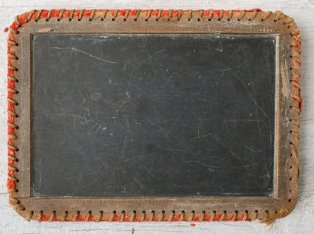 The S.S. Alchymist left Sydney for Brisbane Waters every day at 8.00 am.
The S.S. Alchymist left Sydney for Brisbane Waters every day at 8.00 am.
In May 1872, that ship brought Patrick Hynes school supplies, such as Scripture Lessons, a 'Second Book of Lessons', with two sequels, the 'Third Book of Lessons', Australian Classbook, Framed Slates (blackboards for little hands and the precursor of exercise books to write with pencil or ink in), a Box of 'Slate Pencils', school pens and ink powders.
This 1887 'new fangled desk' was improved so it could have a place for a slate!:
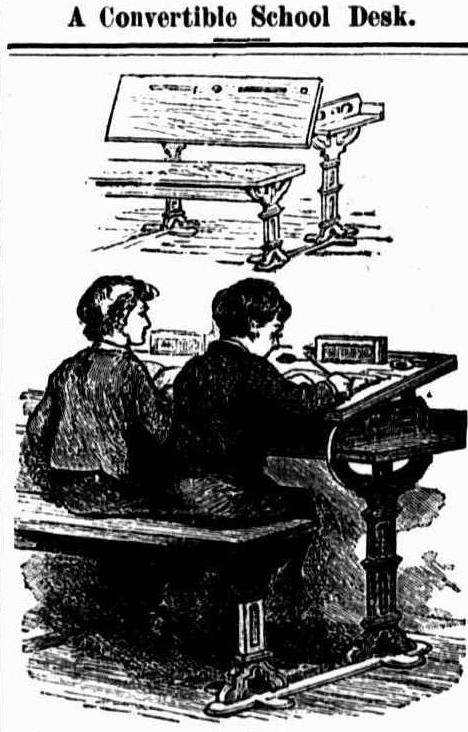 A Convertible School Desk. A School desk having a slot for slates, a book board, and so on, while being capable at the same time of conversion into a seat with a back to it, is illustrated herewith. The desk is readily converted into a backed seat, without ochanging its position, for evening lectures and demonstrations. All the desks in a large school can be converted in a few minutes, and without turning them round. The four positions -which the desk can be altered ....A Convertible School Desk. (1887, October 1). Australian Town and Country Journal (Sydney, NSW : 1870 - 1907), , p. 20. Retrieved from http://nla.gov.au/nla.news-article71089623
A Convertible School Desk. A School desk having a slot for slates, a book board, and so on, while being capable at the same time of conversion into a seat with a back to it, is illustrated herewith. The desk is readily converted into a backed seat, without ochanging its position, for evening lectures and demonstrations. All the desks in a large school can be converted in a few minutes, and without turning them round. The four positions -which the desk can be altered ....A Convertible School Desk. (1887, October 1). Australian Town and Country Journal (Sydney, NSW : 1870 - 1907), , p. 20. Retrieved from http://nla.gov.au/nla.news-article71089623
Mr Hynes was not at Barrenjoey for very long, but lived for a further 8 years before passing away.
Even with a small community life would have been tough at this outpost and since the Customs Station and lightship was established to save lives, as much as monitor vessels coming and going, when such incidences did occur
On October 2, Charles Palmer replaced Patrick Hynes as teacher at the first provisional school, which had been repaired by Albert Black and had a new floor, chimney, etc.
There were 24 students attending the school, eight of whom came from the Customs Station. Mr Palmer was paid £ 4 a month, and there is a letter in which he bemoans a lost October salary cheque, and stating that the school was about a mile from the Barranjoey Post Office.
On October 19, Mr Black, his boatman Frank (Francis) Collins, and the 'Father of Pittwater, John Collins, applied for a provisional school at a building on Collins' property at Careel Bay.
John Collins had many children too!
The building was wooden with a school room of 20 feet x 13 feet. There were three extra rooms for accommodating a teacher, and it was roofed with Hobart Town palings. Eight people signed a declaration claiming there were 30 would-be pupils - 18 boys and 12 girls.
Jervis's Tales From Barrenjoey, researched in the Council of Education School files (Barrenjoey, 1/896, 5/14813.3 A.O.N.S.W.), found that on January 23, 1878, a John Ryan was appointed in charge of this new provisional school. Mr Ryan contributed to the children coming into Barrenjoey, his daughter being born in 1880.
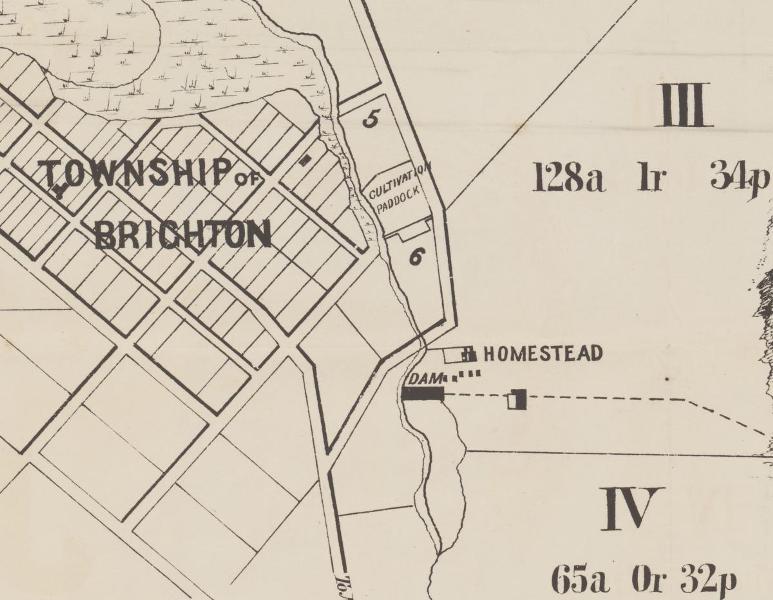
Section from: Careel Bay Pittwater [cartographic material] : township of Brighton, 8 blocks of land with ocean frontage - 1882. MAP Folder 135, LFSP 2160. Courtesy National Library of Australia. See: Careel Bay Jetty-Wharf-Boatshed
A report below describes Careel Bay as 'Brighton' and not too healthy for a new born. What is also quite interesting regarding Mr Ryan is that he was married to a Margaret Hynes in 1875, a lady who 'sponsored' the arrival of an Immigrant, arriving on the Jerusalem in April 1875 under the Immigration Regulations of 1873. Margaret sponsored an 'Edward Ryan, while in the list beside Edward, and sponsored by Ellen Ryan is a 'Michael' - the two travelling together. The 'single females per Jerusalem who were prepared to 'join their friends' could do so from 'The Depot, Hyde Park'. There's more on the 'New Immigration Regulations' of 1873 in the full text of this assisted transportation scheme away from overcrowded Ireland, Scotland and England below and an insight into Irish, Scottish and English women who came here with few or no friends, and were placed at Hyde Park, in From Beneath the Floorboards.
Either way, it seems the Hynes family and the Ryan family knew each other: - a little about this third Teacher at Barrenjoey:
MR. JOHN RYAN.
There passed to his eternal reward on Tuesday, April 23, an old and very highly respected resident of Alexandria, in the person of Mr. John Ryan. Mr. Ryan was a native of Cashel, Co/Tipperary, Ireland, and came to this State sixty years ago. He was married 56 years ago at Raymond Terrace, and for many years lived about the Newcastle district, where he was widely known and highly respected. Later he took up a position as school teacher in the Camden district. For the past seventeen years he resided at Belmont-street, Alexandria. His wife predeceased him nine years. The late Mr. Ryan, although 84 years of age, had excellent health up to twelve months ago, and then, although .ailing,^ he was able to be. about and apparently in his usual health. But only two weeks before his demise he had to take to his bed. Mr. Ryan was a most devout and practical Catholic, and during his illness received Holy Communion frequently, being assiduously attended by Rev. Fathers Kerwick and M'Mahon. Deceased leaves three daughters— Mrs. Michael Cavanpugh, Mrs. 'William Beedle and Mrs. Jas. Dorahy— also one son— Mr. John Ryan. Another son, Joseph, died some four years ago. The funeral, which was largely 'attended, took place on Thursday, April 25, at Rookwood cemetery.^ the arrangements being in the hands of Mr. W. N. Bull.— R.I.P. MR. JOHN RYAN. (1918, May 9).Freeman's Journal (Sydney, NSW : 1850 - 1932), , p. 31. Retrieved from http://nla.gov.au/nla.news-article116772894
BARRENJOEY.
Mr. J. RYAN has been appointed our agent for the Freeman's Journal. BARRENJOEY. (1879, August 2).Freeman's Journal(Sydney, NSW : 1850 - 1932), , p. 12. Retrieved from http://nla.gov.au/nla.news-article110562208
PROVISIONAL SCHOOLS. His Excellency the Governor, with the advice of the Executive Council, has appointed the undermentioned teachers to the charge of the Provisional schools specified opposite their respective names, such appointments to take effect from the dates upon which these teachers, severally commenced duty:- Mr. John Ryan Barrenjoey PROVISIONAL SCHOOLS. (1880, September 22). The Sydney Morning Herald (NSW : 1842 - 1954), , p. 7. Retrieved from http://nla.gov.au/nla.news-article13468571
Pittwater estate belonged to the late Very Rev. Archpriest Therry, who bequeathed it to the Society of Jesus. It is surrounded on all sides save one by water; and it has been highly praised for its salubrity. It has a Catholic church, at which the Rev. Dr. Hallinan officiates once a month; it has also a Provisional school, attended by some twenty children. There is an incipient town called Brighton at Careel Bay, north-west of Barranjoee. The site is eminently unsuited for a township, and the sooner it is abandoned the better. A low swampy beach from which the water recedes at ebb tide, is not well adapted for settling on. A better site is that on the harbour higher up at Long Beach, where there is ‘ample room and verge ' enough, besides a moderately elevated coast and deep water. West Carbery, as we christened the place, is the site for a township.
A large block of land at Stokes's Point is reserved for a College. The scenery at Pittwater and on the greater part of the way thither is simply grand. When the road is better— (Mr. Collins informed us there is money on the estimates to form it all the way), and when a better style of conveyance is available, I know of no place or drive that will present so many attractions to the invalid, the pleasure or holiday-seeker. Everything conspires to quiet the anxieties of the mind and invigorate the body. Wooded slopes and deep ravines, picturesque views of ocean, beach, and headland, are features that would dissipate the megrims of a miser or restore peace to the mind of a rejected swain. Notwithstanding the discomforts we laboured under from the vile vehicle we had, we enjoyed the trip to and fro uncommonly well, and arrived at 7 in the evening at Manly without any mishap beyond that which a little application of Australian Ointment will remedy, as our young friend of bills and briefs said. CRUIG BARRY.11th May, 1880. A TRIP TO PITTWATER. (1880, May 22). Freeman's Journal(Sydney, NSW : 1850 - 1932), p. 19. Retrieved from http://nla.gov.au/nla.news-article133488037
Obituary MRS. J. DORAHY. In last Issue was reported the death of Mrs Anastasia Ellen Dorahy, wife of Mr J. Dorahy, "Marlwood," Mulgo Road, Penrith. Deceased was a well known identity, having spent practically the whole of her life in the district.
Mrs Dorahy was the daughter of John Ryan, a school teacher, and was born at Barrenjoey 63 years ago. Two of her sisters are still living, one at Sydney and one at Brisbane. When she was only 4 ½ years of age deceased's father was transferred to Bringelly, and then on to Werombi. She was married at St. Nicholas' church, Penrith, 40 years ago, by Rev. Fr. Barlow, of Kincumber, to James Dorahy, of "Charleville," Wallacia. Their early married life was spent at Wallacia and they subsequently purchased "Marlwood," Penrith, where the family has resided for the past 22 years.
Mrs Dorahy leaves a family of four boys and three girls, one having died in infancy. There are nine grandchildren. Though her death was unexpected, she had 'been in indifferent health for six months. The deceased lady was essentially a great and lover of home and family and a devout Catholic, highly respected and admired throughout the district. The funeral took place on Thursday afternoon, when a Requiem Mass was hold at St. Nicholas' Church, Penrith, after which the cortege proceeded to the Catholic portion of Penrith general cemetery. The last rites were conducted by Father Massey. Obituary (1943, September 30). Nepean Times (Penrith, NSW : 1882 - 1962), , p. 3. Retrieved from http://nla.gov.au/nla.news-article117893872
The other part of this is of course this was the Construction of Barrenjoey time - a building site is never a safe place for children.
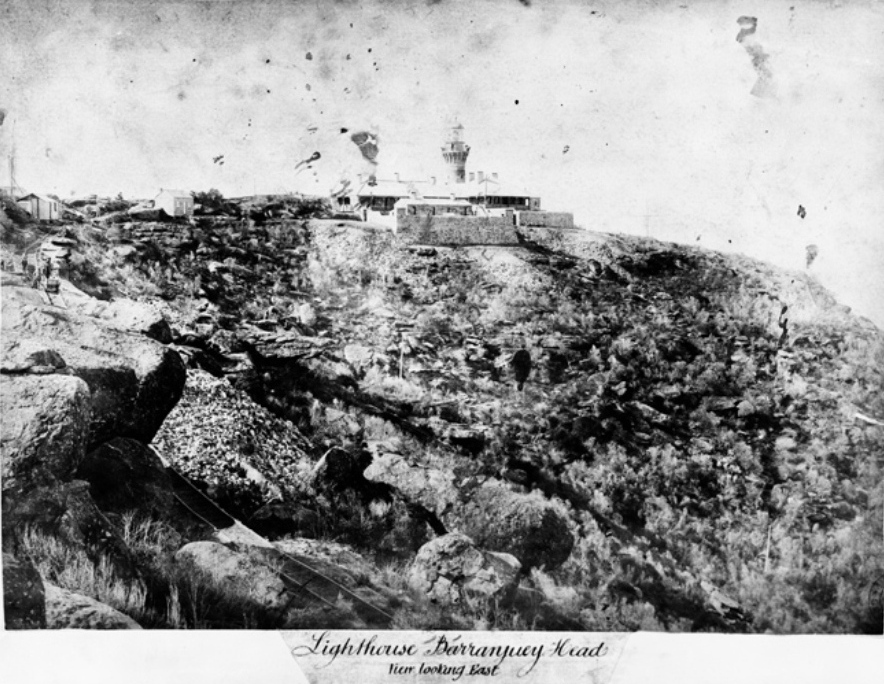
Barrenjoey , showing all the buildings that were once on the path to the tower- courtesy National Archives of Australia
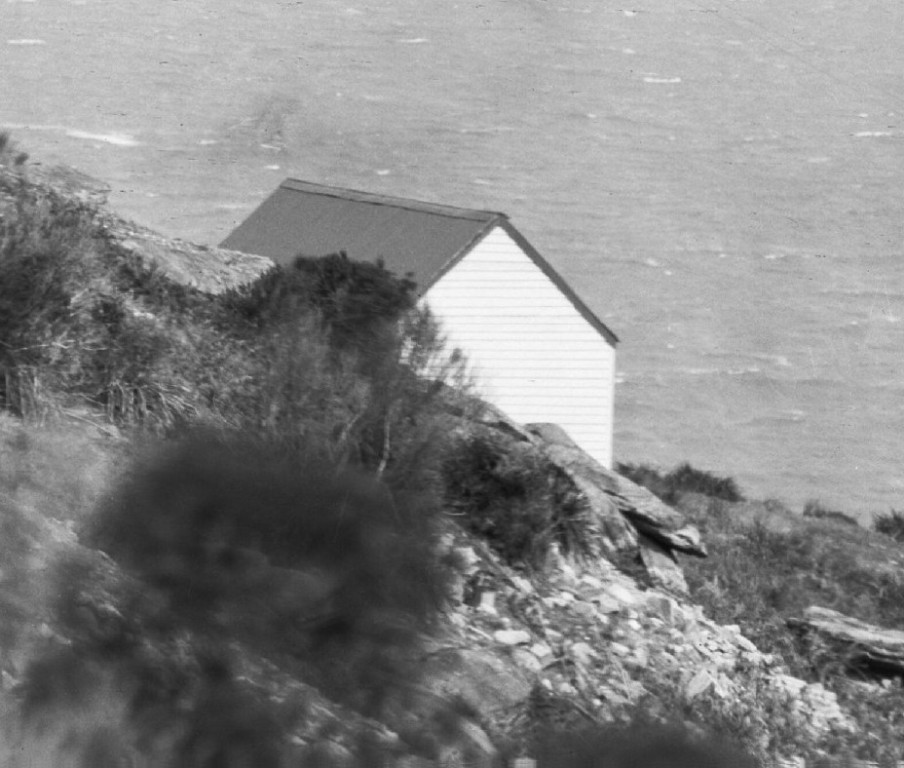
This shed - a section from the top panorama - is missing from above picture
John Collins passed away just after he bought some Careel Bay property, hours after in fact:
‘In the midst of life we are in death' was sadly illustrated in the case of Mr. John Collins, of Pittwater, on Friday night, the 20th inst. Mr. Collins came up the Sunday before to attend the sale of the Pittwater estate, which took place on the 16th inst., his 66th birthday. From Monday to Friday he was making arrangements with a contractor for the erection of a cottage on one of his farms. Returning from Sydney on Friday evening by the half past 5 boat he fell overboard at Lavender Bay wharf, through, it is supposed, the bumping of the steamer against the piles. Owing to the noise of the engine the accident was not observed on the instant, and some short time had elapsed before Captain Butler, who has saved scores of lives from drowning, plunged in to the rescue. He soon brought Mr. Collins on board and proceeded with his steamer to Milson's Point, when he placed him in a cab which conveyed him to his brother-in-law's (Mr. Connolly), the Union Inn. Father Kennedy, S.J., and Dr. V. Browne were immediately in attendance, and both had strong hopes of his recovery until about 1 o'clock at night, when capillary bronchitis supervened. The deceased gentleman was an old colonist, having emigrated from Cork with his parents about 50 years ago. He was well known and widely respected, not only in Pittwater, where he was regarded as a patriarch, and where he resided for upwards of forty years, but also in the North Shore and in Sydney. He was a man of sterling principle, so fond of the right that he would not do wrong deliberately for a kingdom. He had a great contempt for the worldliness, avarice, and selfishness so characteristic of the present times, his own character being the very antipodes of these. On Monday morning a Requiem Mass for the repose of his soul was celebrated by Father Kennedy in the church of St. Mary Star of the Sea. The respect in which Mr. Collins was held was testified by the numbers of all classes who attended his funeral, which was the largest of any private funeral that has taken place here for the last twenty years. He leaves a widow, four sons, and a daughter, all, except one of the sons, living in Pittwater. May his soul rest in peace. ST. LEONARDS. (1881, May 28). Freeman's Journal (Sydney, NSW : 1850 - 1932), p. 10. Retrieved from http://nla.gov.au/nla.news-article115457523
Jervis' states that by July 1881, widow Honora Collins wished to claim back rent at £12 per annum for having the 'school' on their property. The Departmental replied that as the late Mr Collins had never asked for rent, the widow had no claim to ask for rent either, and furthermore, no rent was ever paid for provisional school premises.
More problems were brought to bear on that little school when Mr. Ryan, was reprimanded for closing the school for three weeks during August and September. Ryan claimed that he had closed the school at the request of the parents. It had been decided that due to wet weather and bad roads, it was better for the children to stay at home rather than run the danger of getting sick of school in wet clothes. The Inspector counter-claimed that the children had just not wanted to go to school, and that the parents had not urged them to do so. The penalty was that Ryan was docked three weeks pay - he was being paid £ 7/10/- monthly.
Mrs. Collins struck back at the Department by telling the hapless Ryan to quit the school's premises by February 1, 1882. As a result, the school was moved back over Observation Point, to the old lighthouse keepers' quarters.
Tales from Barrenjoey relates that the current third tee of the Palm Beach Golf Course marks this location.
The move caused complaints from the residents of Careel Bay that their children would be deprived of the means of education - Barrenjoey was going to be more than two miles away, outside the 'new' as outlined in the 1880 Education Act by the Department of Public Instruction.
The Chief Inspector responded that as there were only ten child involved, they could easily attend the school at Barranjoey. The eleven children from the lighthouse and Customs Station would have a school on their doorstep and a shorter distance for the seven children from the Basin to row.
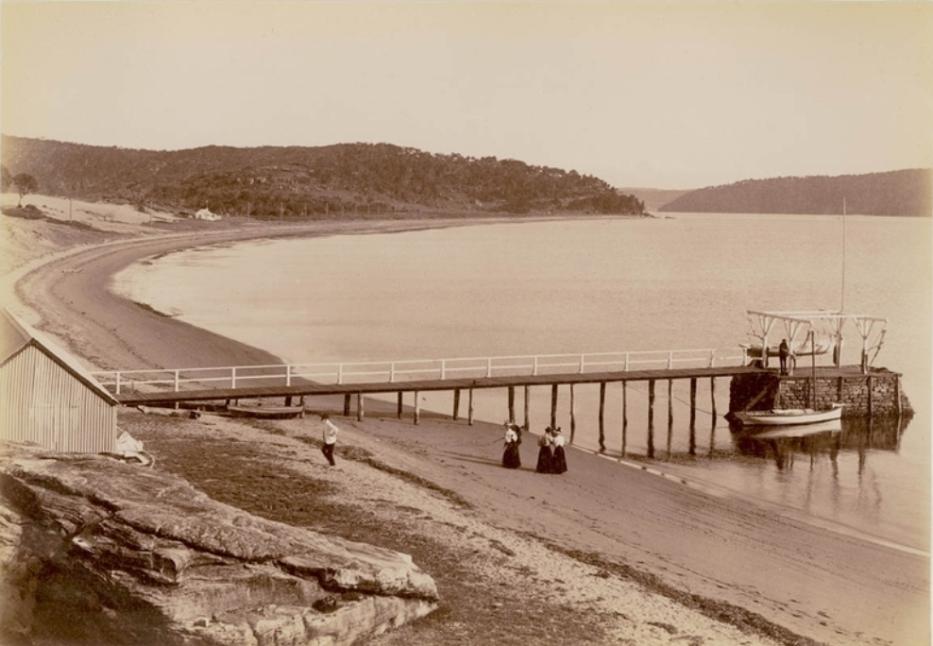
Above: Wharf, Barrenjoey, Hawkesbury River, 1900-1910. Pic No: a116421, Courtesy of The State Library of NSW
The lighthouse children did not like the school and did attend. Teacher Ryan wrote to J.H. Murray, the Inspector at Parramatta, that he had written to the lightkeepers about not sending their children to school. Writing to someone who lives just over the hill, clearly someone else, 'the mail route' tenderer, was delivering these messages.
Tales from Barrenjoey states 'George Mulhall, the first assistant lightkeeper, hadn't been sending his boy (8 years 9 months, December 1882) to the school, and deigned not to reply. William James Steere, the other assistant keeper, did respond, stating '...my children are being regularly and efficiently instructed at home up to the standard of education required'. His postscript stated that he had four children between the ages of six and fourteen.
On February 12, 1884, George Mulhall wrote asking for a replacement for Mr Ryan, but inter-departmental correspondence Indicated that no successor was available. Another point addressed was the recommendation that the school be converted into a Public School due to the increased attendance. There were over thirty pupils now at the school. The dilemma being that the buildings still belonged to the Government Harbours and Rivers Department.'
As an interim measure, Mr Stevens came to Barranjoey on March 1, 1884, and served until October 4, when he transferred to Lord Howe Island:
THE Hon. W. J. Trickett, Minister for Public Instruction, has decided to reopen at Lord Howe Island the Public school which was in existence there some time ago, and which was closed in consequence of the small attendance of children. He has also decided to proclaim the island a Public school district in which the compulsory clause of the Public Instruction Act shall have effect, and the necessary proclamation will be issued in a week or two. Mr. Stevens, who was the teacher of the school at Lord Howe Island before it was closed, and who recently has been stationed at Barrenjoey, has been appointed to the new school, and he will leave in a few days for Lord Howe Island with Mr. Wilkinson, the visiting magistrate. NEWS OF THE DAY. (1884, October 3).The Sydney Morning Herald(NSW : 1842 - 1954), , p. 7. Retrieved from http://nla.gov.au/nla.news-article13568923
New Public School.— It is proposed to establish a Public school at Mount Arthur, near Gundagai, and at Barranjoey. Government Gazette. (1884, March 15).The Sydney Mail and New South Wales Advertiser (NSW : 1871 - 1912), , p. 523. Retrieved from http://nla.gov.au/nla.news-article164384462
Documents Jervis sighted state that on April 22, 1884, Mr Smith proposed that a new school be located at Sandy Point, Palm Beach and sketched a rough map of where it should be. On it were marked the Smiths, at the bottom south-east corner of Careel Bay (Captain Smith was at the ‘Bason’ and Hastie, the old Collins farm school site.)
Clearly The Sydney Mail and New South Wales Advertiser didn't get to Barrenjoey all that often, even with steamers and visitors and a mail service.
On October 20, 1884 of the replacement teacher Samuel Turtle, his wife Margaret, and son Henry James Mulholland arrived. Their copperplate signatures are in the Barrenjoey visitors' book. The keepers and Coast Waiters were occupied with the new school to be built at Sandy Point.
There was also a fair amount of other distracting activity in the area during 1884 to 1885, see First Naval Exercises by New South Wales Colonial Ships – The Wolverene at Broken Bay - and:
THE NAVAL VOLUNTEER ARTILLERY. H.M.C.S. WOLVERENE, BARRENJOEY.
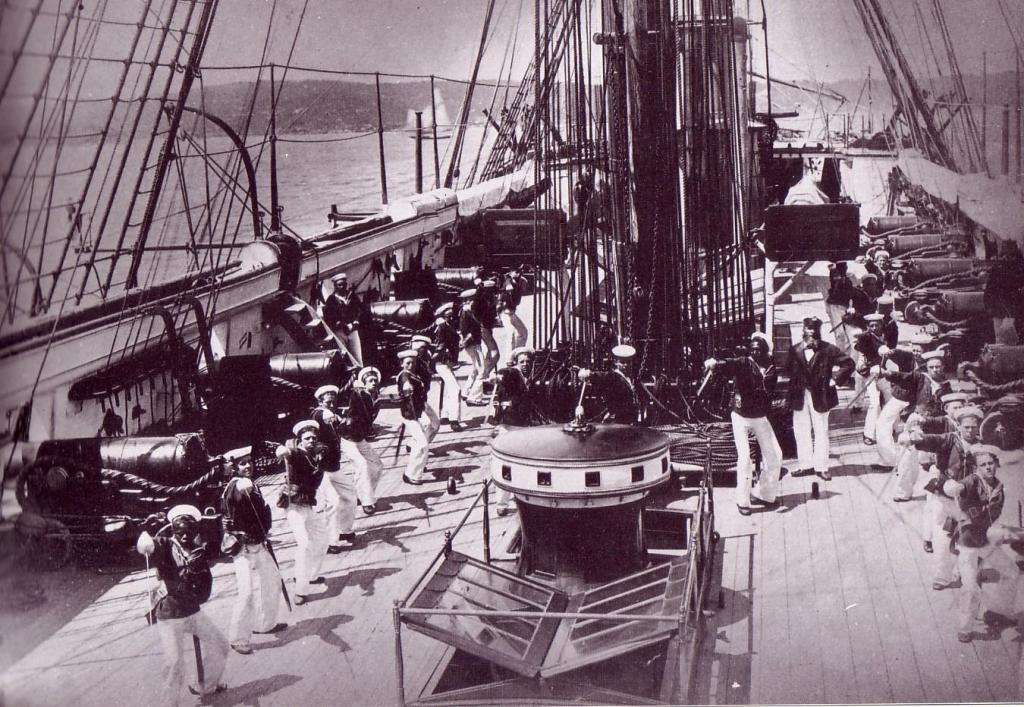
HMCS Wolverene: cutlass drill, 1882, courtesy State Library of NSW.
Sunday.On Friday evening the volunteers gave an amateur minstrel concert, which though a first performance was really excellent, most of the singing and the play of the corner men being much above the average. Captain Taylor having kindly lent his piano, it was taken out on to the quarter-deck, and Tait, one of the volunteer blue jackets, played the accompaniments to the various songs in a most creditable manner. The whole affair was an unqualified success, and great praise is due to those who worked it up. Yesterday all hands were up to scrub and clean decks at 5.30 a.m. Breakfast followed at 7 a.m., and after the division at 9.40, the order was given for gun drill for the volunteers, the four pounders on the quarter-deck were manned and cast loose, blank cartridges were served out, and both single guns and broad-sides were fired. Forty-two rounds were dis-charged, and the men showed that they were making rapid progres in gun drill. In the afternoon a firing party was formed, and all hands were given liberty on shore. In the evening there was more fishing with the seine net, and later on the officers fired a large number of rockets and signal lights. After cleaning decks this morning, all hands were called aft to the quarter-deck for divisions and inspection. Service was held at 11 o'clock, when a most impressive sermon was preached by the Rev. Mr. Hillyar, the chaplain on board. The men are this afternoon doing out-boat sailing, pulling, &c. The provisions used during this cruise were supplied by Mr. James Kidman. These on the whole are good, but great dissatisfaction is ex-pressed by the officers and men at there being no potatoes sent up. THE NAVAL VOLUNTEER ARTILLERY. (1884, April 14). The Sydney Morning Herald (NSW : 1842 - 1954), , p. 6. Retrieved from http://nla.gov.au/nla.news-article13572211
The Inspector's report of April 25, 1885, described the two acre site for the new school as commencing at a telegraph pole marked X, 22 chains (442 metres) from the grave on Chinaman's beach (Snapperman Beach) along the road to Careel Bay. As this was part of the Bassett Darley Estate, a price of £ 25 per acre with a frontage to the water, was deemed ample value for the land.
In December, the land was officially resumed, and a building was constructed by Mr F. Collins at a cost of £180. This next schoolhouse measured 36 feet x 20 feet x 10 feet high, and it was made of hardwood timber, with a galvanised corrugated iron roof.
Resumption of Land.-Certain land situate at: certain land forming part of the Bassett-Darley Estate; James Napper's 400 acres, situate at Barrenjoey, parish of Narrabeen, county of Cumberland, containing by ad measurement 2 acres more or less; GOVERNMENT GAZETTE. (1885, December 9). The Sydney Morning Herald (NSW : 1842 - 1954), , p. 7. Retrieved from http://nla.gov.au/nla.news-article13606027
Resumption of land at— continued. Basset-Darley Estate at Barrenjoey, Parish of Narrabeen, for Public School 7852 Index page (1885, December 31). New South Wales Government Gazette (Sydney, NSW : 1832 - 1900), , p. xiv. Retrieved fromhttp://nla.gov.au/nla.news-article219881030
Jervis' research shows this building was opened, officially, on January 25th, 1886: so something else must be getting 'worked' on in the area - as fishermen, or roads that drew these men to the same area just weeks later.
Five young men named Frederick Caine, Henry Johnson, John Williams, William Reilly, alias Beck, and' William Lindsay, alias Lynoh, were charged with having stolen a watch, a watch key, a pocket knife, and three artificial teeth, value £4, the property of James A. Bailey. The case for the prosecution was that on the 18th instant the prisoners were seen to enter several tents near Barrenjoey, one of which was occupied by the prosecutor, a contractor; four of them went into three tents, and one (Johnson) remained outside; they came out, and went on to towards Barrenjoey ; when the men came back from work they found that their tents had been entered, and missed various articles ; they went in pursuit of the prisoners and came up with them near Barrenjoey. The prisoners ran away and were subsequently arrested near Narrabeen by Senior-constable Sobye, and Constable Miller, of Manly. There was a second charge of stealing five plugs of tobacco, a silver ring, and a razor, valued 12s., the property of John Scott, from one of the tents. Some tobacco similar to that stolen, was found in the possession of some of the prisoners. Lindsay and Reilly were sentenced to a month each on each charge, and the other three to 14 days each, all the sentences to be concurrent. The two first named prisoners had been already convicted several times, and the other three bore bad characters. During the hearing of the case they conducted themselves in an impudent and flippant manner, and appeared to regard their position as the subject for amusement. POLICE. (1886, February 24). The Sydney Morning Herald (NSW : 1842 - 1954), , p. 7. Retrieved from http://nla.gov.au/nla.news-article13612359
This school officially opened on January 25, 1886.
Tales from Barrenjoey states the following school furniture was forwarded per the S.S. Marramarra in the care of Mr A. Black; 4 Desks, 9 feet long, 4 Forms, 9 feet long (chairs for our younger readers - these were a long bench like those in the picture below) 1 Book-press, 4 feet x 3 feet x 18 inches deep Table, 3 feet x 2 feet, with two drawers, Bentwood chair and 24 American School-House hat pegs, No 92, on batten.
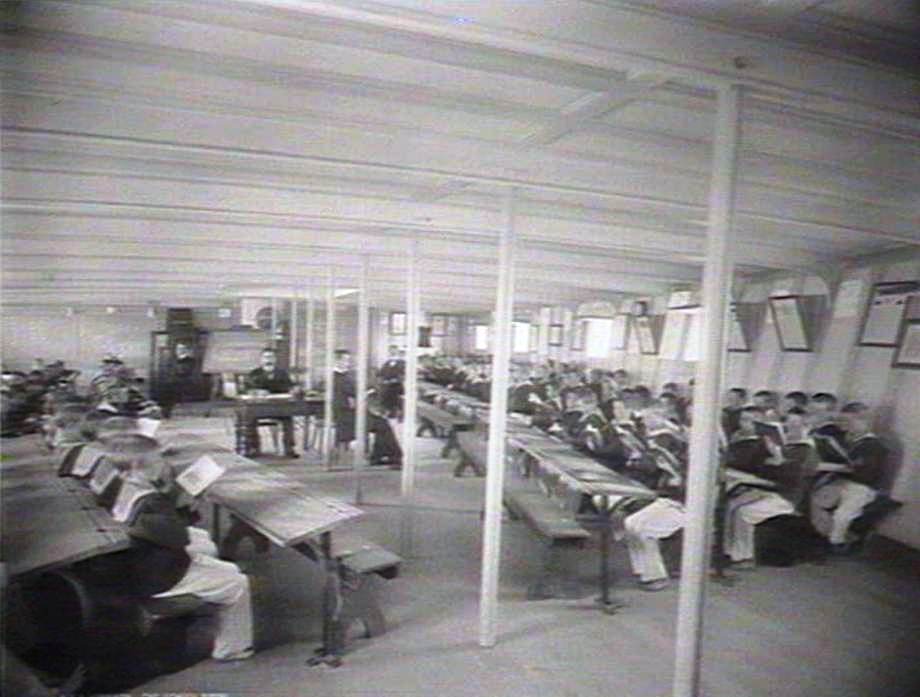
'The School room' - 1898 - aboard the Sobraon (ship)Iamge No.: d1_12601, courtesy State Library of NSW, the Mitchell Library.
A feud soon developed between the lighthouse keepers and the family of the new Teacher, Mr. Turtles. Samuel Turtle wrote to the Department on January 14, 1885, informing them that none of the children from the lighthouse or Customs Station had been expelled. A memorandum was subsequently sent to the District Inspector, W. McIntyre by the Chief Inspector, J. Maynard on December 19, detailing James Steere's complaint against the teacher's wife, alleging that Mrs Turtle had told his daughter Mary that `if she came to school again, it would be the worst for her'. She had also called her daughter a `villain' in front of the other school children. Mr Steere complained that his request for an explanation was treated with contempt.
The Departmental Inspector checked into the matter. He responded,
... that Mary is an active, intelligent, young girl, nearly 15 years of age, and attended school until October last. Mrs Turtle states that this girl's conduct was often unbecoming, and sometimes immodest. She would play rudely, sit on the playground with her clothes above her knees, and was very fond of talking to the Master at playtime.
The memorandum continued with denials from both parties, although Mrs Turtle admitted to being so enraged with Mary on one occasion, that she had called the girl a villain, and told her not to come back to school. The Inspector then reported,
The Master states that he did not see any misconduct on the girl's part, and it appears that Mrs Turtle is jealous of this girl, imagines she is bad, and too old to attend school.
The memo concluded with the recommendation that Mrs Turtle be censured, and that Mr Steere be informed that his daughter be returned to school, as Mrs Turtle has been cautioned not to interfere with her.
On March 29, 1886, Mr Steere replied to the letter he 'had the honour to receive'. This letter to the Under Secretary of the Department of Public Instruction said,
‘... we are doing our best to get our children taught at home for I cannot in justice to them, send them to school any longer, after the false and scandalous things said about my daughter Mary by Mrs Turtle...’
Mr Steere added that he had pulled the rest of his children out of school on January 22. Inspector Sharp replied by telegram, threatening prosecution if Mr Steere did not return his children to school. Mr Steere that he would rather be fined. Furthermore, he wrote that ' things ought to be different when compulsory education is the law of the land ... Sir, if you only knew the truth, I am confident you would commend me for not sending my children to Barranjoey School'.
Compulsory school attendance had started in 1880. Mr Steere backed down, and on August 10, 1886, sent a telegram to the Education Department minister, saying that his children would return to school following Monday. The problems continued though with the children of the lighthouse allegedly physically attacking the Turtles son and Mrs. Turtle retaliating and Mr Steere taking his children out of the school once more, stating his six year iold had been beaten by Mrs. Turtle.
Mr Turtle replied in a letter to the Department Inspector, dated December 11, 1886:
‘As requested by you I beg to state that my boy, seven years of age, has been beaten time after time by the Lighthouse children whose ages range from six to fourteen years. I always told Mrs Turtle that for peace sake to say nothing about it, but on the last occasion she informed me that her child was not to be murdered and accordingly she beat Rachel Steere on the hands with her own hand, who had previously struck my boy with a piece of wood on the head, the effects of which he found for some days afterward. It may be well to state that the Lighthouse children had frequently requested the Careel Bay children to beat my little boy because he was an Irish boy of the wrong stamp. Careel Bay children refused to do so; the Lighthouse children seeing that there was no chance of getting their instructions carried into effect went to work themselves. After Rachel Steere had done her part, a boy named George Mulhall, aged about 14 years, another bird [last century name for a street kid], struck my boy several blows on the head with his fist. Mr Steere has been in the habit of taking We daughters home on sewing days which are from 2 to 3.55 o'clock F.M. on Tuesday and Friday in each week. If his children, according to custom, had left the school when it was dismissed at 12.30 o'clock P.M. on the sewing day of the alleged complaint nothing would have occurred; Mrs Turtle remarking to me with they remained so long on that particular day, and stating that eh believed they were there for some bad purpose. I conclude stating that I caned the boy George Mulhall, giving him strokes on each hand.’
This spat ended when the Department, protecting their own, agreed with the actions the Turtles. Under the date, 28.12.86 and signature, the Under Secretary added the postscript `I concur'. The Departmental Inspector's letter to his chief agreed with the above letter, stating that the Steere children were in the habit of beating other children. Hence, the action taken by Mrs Turtle was necessary.
William George Stevens, who had taught at Barranjoey in 1884, returned to take charge of the school on September 13, 1887. He seems to have had an amicable relationship with the children and parents, as no vituperative letters are on record. An indication that Mr. Stevens, sometimes spelled 'Stephens', continued to develop himself:
Teachers Promoted. — The following teachers have gained promotion by examination: W. G. Stephens, Barranjoey, 3 B (provisionally) ; Government Gazette. (1888, August 30).Evening News (Sydney, NSW : 1869 - 1931), , p. 7. Retrieved fromhttp://nla.gov.au/nla.news-article107322088
The following are some of the memoranda which appeared in his file - per Tales from Barrenjoey:
May 28, 1889: Closed the school as his children were sick. July 1889: The school building was much injured by white ants. The damage done was repaired by carpenter J. Booth for £ 6/151- December 27,1889: Mrs Stevens commenced giving sewing classes. February 1891: The school buildings were very dilapidated, especially the living quarters. Two of the children had to sleep in a school-room. Mrs Stevens refused to pass another year at the school because the cold and draughts were giving the family bad health. August 31, 1891: Mrs Steven's daughter, the senior girl at school, took over giving the sewing lessons. February 1892: Mrs Stevens has been away ill for many months. Following letters concerned the ill health of the couple, with requests for transfers.
The Department finally took heed of these pleas. A memorandum of May 3, 1992 described the route a teacher should have to take to reach Barranjoey. `By coach from Manly, leaving about 10 AM each day, reaching Newport about 12. Thence by boat or horseback 7 miles to Barranjoey'. The suggested cost was about £ 1/5/- per person.
On May 16, Arthur Day was instructed to ‘test' the school at Barranjoey as a temporary teacher. He went on May 20. By January 1893, the termites had again damaged the school and Mr Day complained. The Chief Inspector was loath to incur more repair costs so suggested that a drum of ‘ant exterminator be used with a syringe, and to follow the directions carefully'.
A new feud erupted on August 18 over the Customs Station children, when Mr Day wrote letters reporting the suspension of John F. Madden, 16 years old, for rudeness, and also that he had reproved one of John's sisters. In November, Mr Day contacted the Department with a request for his own `removal' from the school.
Frank Eckman, Customs station boatman, was another Barranjoey resident who removed his children from the school. Letters of December 5 gave the main reason as teacher neglect, claiming that Mr Day often sent the children home early, once even before 11 am. Furthermore, he had repeatedly insulted the children, saying he would rather teach 'a lot of blacks' and doubted whether they were teachable as they were `like machines’,. Mr. Eckman added '...he has spoken in a very insulting manner of the Catholic Religion, and as my children are young it might make an impression on them', and he also accused Mr Day of reading in hours.
Mr Day countered. He admitted having used the word ‘machine', but claimed that the Eckman children (aged 9 and 7) would have been too young to understand the phrase. He replied that the religious issue had been dealt with previously as a result of a complaint from Mrs Madden. He also cited a history lesson which had been given to the class, but which had not been attended by the young Eckmans. He wrote that he had not neglected the school children, and quoted a favourable extract from the school visitors' book which had been written by Mr F. Smith, an ex-Mayor of North Sydney. Mr Day explained that his reading in school was either mail or school notes, although he may have been studying to further himself, as indicated above.
The strong religious convictions of some of the parents of the children who attended the Barranjoey school, can be derived from Michael Madden's Obituary, published on March 16, 1894 - these kinds of Notices and 'In Memorium' s appear years after the loss of a loved one. In part this stems from Catholic traditions of Prayers for The Repose of the Soul. The Barrenjoey community, what can be inkled through their threads, stuck together though - many, like the teachers sent, had escaped from Ireland and a dim future, or were one generation later from those who had - they probably didn't like 'authority figures' -especially ones sent out by a 'Public Instruction' Department - it just reeks of and conjures up Pink Floyd's 'The Wall' as soon as you hear that name.
There are records of John Collins collecting money to send back to Ireland to support those railing against the desecration of their faith, their ways of life, their land, their language - their everything. These were salt air and salt water people, of the earth, most probably acutely aware of a class system and what was even then white collar/blue collar who hadn't been able to gain any education other than seeking knowledge. Many of the earlier teachers, as outlined through the NSW State records, were very young to be telling others what to do too - probably not the best approach for people wise beyond their years who 'got on with it' when they had to rescue those in peril at sea. It would also be reasonable to realise that people who have to attend to the dying or deceased, as part of their work and regularly, certainly have a keener sense of how precious their own lives and the lives of others are - how could they not?
DEATH OF MR. MICHAEL MADDEN.
This very old resident, one of the pioneer settlers of Pittwater, passed away on the 16th instant at the age of 63. For 38 years he had been employed under the Sub-Collector of Customs at Barrenjoey and had been one of his most trusted men. A devout, practical Catholic, Mr. Madden' s life was always exemplary. He was generous in his nature to local charity calls and ever ready to respond to the cry of distress from any quarter. He was a warmhearted Irishman and followed the course of events in the old country with keenest interest. The Irish and Catholic news as given in the Freeman from week to week he knew by heart, and since the death of his friend, Mr. John Collins, the patriarch of Pittwater, and an oracle in general history, Mr. Madden was looked up to as an arbiter on memorable events. The Rev. Father Brosnan was very attentive to him in his last illness and attended the funeral to the Waverley cemetery. Among others present were Mr. Roche, of Bay View, Mr. Wilson, and Mrs. Black, widow of the late Sub- Collector of Customs. Mr. Madden left a widow and family, one of whom has joined the Sisterhood of the Good Samaritan at Manly. — R.I. P. DEATH OF MR. MICHAEL MADDEN. (1897, February 27). Freeman's Journal (Sydney, NSW : 1850 - 1932), , p. 19. Retrieved from http://nla.gov.au/nla.news-article115470805
MADDEN. — February 16th, at his residence, Barrenjoey, Michael Madden, aged 63 years; for 40 years in H.M. Customs ; leaving a loving wife and large family to mourn their loss. Sweet, Jesus have mercy on his soul. Family Notices (1897, February 27). Freeman's Journal (Sydney, NSW : 1850 - 1932), , p. 10. Retrieved from http://nla.gov.au/nla.news-article115470769
MADDEN,- In loving remembrance of my beloved husband and our dear father, Michael Madden, who died at Barrenjoey February 16th, 1897. Sweet Jesus have mercy on his soul. Inserted by his loving wife and children. Family Notices (1901, February 16). The Sydney Morning Herald (NSW : 1842 - 1954), , p. 1. Retrieved from http://nla.gov.au/nla.news-article14341026
Bureaucracy triumphed again when the Chief Inspector wrote over both letters that the teacher's explanation was to be accepted. The days of the last school at Barranjoey and its teacher were numbered. On February 2, 1894, a statement was put out that although the enrolment was 8 students, attendance was an average of 6, and likely to decrease.
An idea to start a school at Wilson's Beach (Currawong) on the opposite shore of Pitt Water, was deemed inadvisable because there were too few pupils, no school room available, and the residents had manifested no desire to provide or help to provide one. The cost to the Department to construct one would be £32, and there boat approach only.
On February 14, 1894, the Under Secretary agreed to close the Barranjoey school, and a week later, Mr Day was on his way to Wallambuie Provisional School.
THE.LATE ARTHUR DAY. On Friday morning last there passed away at Parramatta one who was widely known in our district in the person of Arthur Day, for many years teacher of the Jamberoo Public School. Born at Croydon, England, he came to this Colony as a young man and joined the Education Department of this State. His first appointment was to Barrenjoey, and from thence to Wiseman's Ferry, and it was here that he met and married Emma, the second daughter of the late Mr and Mrs Henry Fredericks, of "Moss Leigh", Jerrara who now survives him as well as three of a family, Dorothy (Matron of Mc-Arthur House, King's School, Parramatta), Frank and Mark, both of Sydney. Mr Day's next appointment was to Cockle Creek, thence to Stuart Town, Bullahdellah and Jamberoo, and lastly Carlingford from whence he retired some two years ago to live in his quiet home on the outskirts of Parramatta. But it is as the resident school teacher of Jamberoo that I write of him. Mr. Day was a very deep reader and a good conversationalist, but of rather a retiring disposition. With regard to his pupils he always believed in using a kind word rather than chastisement. His motto was "A kind word spoken at the right time should be one of the guiding Principles of life" He was also interested in agriculture and was one of the first teachers on the South Coast to induce his pupils to go in for garden plots, both flowers and vegetables, and was overjoyed when the Kiama Agricultural Society allotted prizes for school plots, Jamberoo School winning on several occasions. Mr Day also took a keen interest in the chief industry of our district - dairying - and when a Babcock tester was presented to the school, it was his joy to teach the older pupils the specific gravity and butterfat content, etc. from milk brought to the school by pupils one afternoon a week. He was also a member of the Masonic Craft, and several times held office in the Kiama Lodge while a resident of Jamberoo. Now his earthly pilgrimage has finished and after retiring some two years ago he has passed on to the great Be-yond from where no traveller returns. Mr Day went under a very critical operation some nine months ago from which he really never recovered and despite all the love and attention possible, his spirit passed to the Great God who gave it, on Friday, March 31st. ere the Easter week had dawned, leaving behind a good name which is the best monument any citizen can have. Farewell Arthur Day, Farewell. THE LATE ARTHUR DAY. (1939, April 5).The Kiama Reporter and Illawarra Journal (NSW : 1899 - 1947), p. 3. Retrieved from http://nla.gov.au/nla.news-article102052355
James Booth purchased the school house, dismantled and removed it, filled in all the holes, and sent the Education Department a cheque for £ 9 for the salvaged material. The nearest school was now at Newport, which those of school age either walked or rowed to.
Finally, on August 1, 1898, Frank Eckman, Isaac Newman (keeper), Lizzie Smith (William Smith's wife) and Nancy Mulford (wife of Mackerel Beach orchardist) proposed that Miss A Madigan be appointed as an itinerant teacher. The school would be located in a room in Lizzie's cottage and Miss Madigan would be accommodated at the Eckmans's home for 15 shillings per week. She had been instructing the children there for 2 years, presumably as a tutor.
On December 22, 1898, the Acting Inspector visited the lighthouse and the Customs Station, with the view of establishing a school. This was vetoed due to the lack of school age children and the rough crossing of Pitt Water in bad weather. In 1899 applications by residents of Barranjoey and Careel Bay were again refused, for the same reasons.
The children continued were without the required Teacher until a proposal to use launch to transport them to school allowed Bill Sykes to tender a offer, eventually won the contract, and started the first school launch service in Australia in April 1904. For the first four months he always kept to schedule, despite rough weather. The Patonga was a thirty foot motor launch with a beam of eight feet and powered by an 8 hp Hercules engine. James Booth, a jack-of-all-trades (he built a cairn, since destroyed, on Barranjoey Headland to mark an original lighthouse site), was always interested in the Palm Beach school land. On September 28, 1898, he unsuccessfully applied to rent the two acres, offering £ 2/ 12/- per year. He tried again on March 29, 1917, that time for only One acre at 2/6d a week. In his application to start a small boat hire business, he promised not to `put up any unsightly buildings'. Despite this remarkable environmental impact statement for that time, The Education Department still refused his application, advising that the land had been transferred to the Barrenjoey Company and later to what became the Palm Beach Land company. Today, there is still a portion of that land, Iluka Park, which has been retained forever, as a recreational area for the public, thanks to Warringah Shire Council, and its 1920's program of acquiring reserves and access to water for people, insisting the company hand over part of the land for a park. This was the site of the old school.
From the October 1927 - Warringah Shire Records of Minutes of Meetings:
5. Palm Beach Lands Ltd. re proposed subdivision of "Old School Site" in Barrenjoey Road Resolved(Crs. Hitchcock, Simpson) - That the plan be approved, and the necessary action be taken to secure the dedication of the 2-ft. reserve at the end of Iluka Road, the Seal to be affixed to the plan when this matter is finalised. 5. Palm Beach Lands Ltd. re proposed subdivision of "Old School Site" in Barrenjoey Road Resolved(Crs. Hitchcock, Simpson) - That the plan be approved, and the necessary action be taken to secure the dedication of the 2-ft. reserve at the end of Iluka Road, the Seal to be affixed to the plan when this matter is finalised.
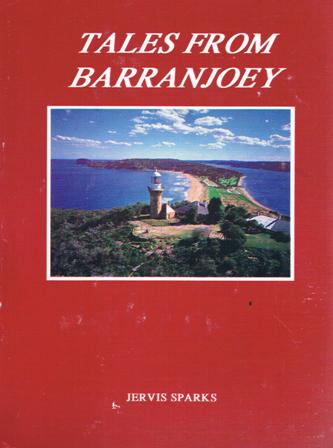 The Schools of Barranjoey Tales from Barrenjoey. Jervis Sparks. 1992, pages 91 - 109
The Schools of Barranjoey Tales from Barrenjoey. Jervis Sparks. 1992, pages 91 - 109
SCHOOL LOCATIONS
1 Sand dunes, Barranjoey isthmus, 1872 - 1876
2 Careel Bay, between Hitchcock Park and Currawong Street, 1878 - 1882
3 Palm Beach Golf Course, Governor Phillip Park, 1882 - 1886
4 Iluka Park, Palm Beach, 1886 - 1894
SCHOOL STATUS
Provisional School August 1872—April 1876 January 1878—April 1884
Public School April 1884—February 1894
Teachers
Patrick Hynes 1871- 1872
Charles Palmer 1872-1876
John Ryan 1878 -1884
William George Stevens 1884, 1887-1892
Samuel Turtle 1884-1887
Arthur Day 1892 – 1894
____________________________________
Tales from Barrenjoey. Jervis Sparks. is in the process of being digitised for an E-Book edition we hope to have ready later this year - all permissions granted, Jervis happy with it etc. - Stay Tuned!
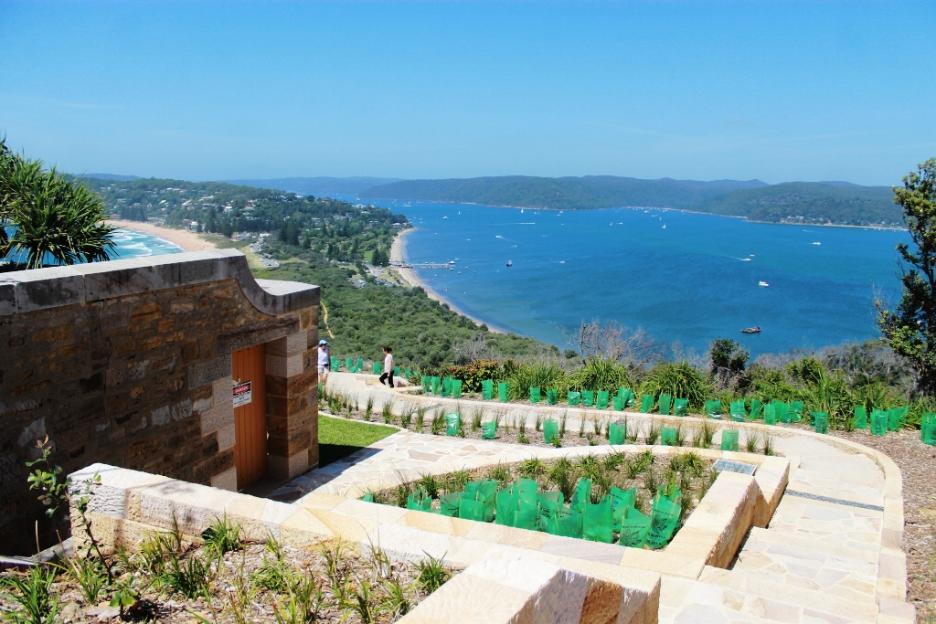
Records Relating to the Barrenjoey School Teachers and Residents
James Madden, an old resident of Barrenjoey, and lately employed in the cutter Marion, trading between Sydney and Broken Bay, fell overboard on Saturday morning when the vessel was rounding the North Head of Sydney. GENERAL NEWS. (1880, November 27).Freeman's Journal (Sydney, NSW : 1850 - 1932), , p. 15. Retrieved from http://nla.gov.au/nla.news-article133486331
The S. M. Herald's Barrenjoey correspondent telegraphs as follows on Sunday:-The ketch Favourite, Erick Erickson, master, which put in here to-day, reports that he left Sydney at 8.30 a. ra. for Cape Hawke, and that when about east of Little Reef a sea struck the vessel,washing overboard Nicholas Dubleich, able seaman, and at the same time shifting the ballast. The captain hove the vessel to, but the man was only seen once some distance astern, and it was considered dangerous and useless to attempt to launch the boat in the then state of vessel and sea. The captain's statement is confirmed in all essential particulars by the mate, John Johnsen. The ketch Bell Bird, for Sydney, is also at anchor here. MISCELLANEOUS ITEMS. (1885, March 5).The Maitland Mercury and Hunter River General Advertiser (NSW : 1843 - 1893), , p. 3. Retrieved from http://nla.gov.au/nla.news-article18946214
TENDERS ACCEPTED - road from Manly to Pittwater, £287 10s; J. Sparks, contract 26-o, TUESDAY, JANUARY 5. (1886, January 9).Australian Town and Country Journal (Sydney, NSW : 1870 - 1907), , p. 15. Retrieved from http://nla.gov.au/nla.news-article71071603
Collins, late of Barrenjoey, Pittwater, in the Colony of New South Wales, boatman, deceased, intestate ... 100 words
COLLINS. - May 9, at Barrenjoey, Broken Bay, Francis Collins, in his 62nd year. Family Notices (1886, May 14). The Sydney Morning Herald (NSW : 1842 - 1954), , p. 1. Retrieved from http://nla.gov.au/nla.news-article28357525
COLLINS’S— In loving remembrance), of John Collins, of Pittwater, who died 21st May 1881. Jesus have mercy on his soul. ' Inserted by his loving wife.
COLLINS— On 9th May, 1886. at Pittwater, Francis Collins, brother of the late John Collins. Jesus have mercy on his soul.Advertising (1886, May 22). Freeman's Journal (Sydney, NSW : 1850 - 1932), , p. 10. Retrieved from http://nla.gov.au/nla.news-article119446348
This is Church Point -
ESTABLISHMENT OF PUBLIC SCHOOLS.- In Kegworth, near Summer-hill ; in Cobar (evening) ; evening schools in Blackfriars, Pittwater, and Redfern. Government Gazette. FRIDAY, AUGUST 1[?]. (1886, August 21). Australian Town and Country Journal (Sydney, NSW : 1870 - 1907), , p. 17. Retrieved from http://nla.gov.au/nla.news-article71066479
This visit by Royalty, who did meet Coats Waiter Albert Black, may be read about further in - Mount Loftus, Newport and The Newport Wharf -
During the next week the Princes made a trip to the Blue Mountains, at the invitation of Sir Henry Parkes, and they afterwards went to Pittwater, Broken Bay, and the Hawkesbury rivor. The mountain scenery impressed them, and they were charmed with the beauty of the Hawkesbury. " We sit or stand about on the bridge amidships," they say, "and look out and around on the over-changing and yet constant loveliness of the river, which every now and then narrows between islands that seem to close in all passage ahead." THE CRUISE OF THE BACCHANTE. (1886, August 14). The Sydney Morning Herald (NSW : 1842 - 1954), , p. 7. Retrieved from http://nla.gov.au/nla.news-article28358651
Patrick Hynes lived for a further eight years after leaving Barrenjoey
THE FRIENDS of PATRICK HYNES are respectfully invited to attend his Funeral ; to move from his late residence, Denison-street, Waverley, THIS (Saturday) AFTER-NOON, at 3 o'clock, to the Waverley Cemetery. THE FRIENDS of Mr. JOHN HYNES are respectfully invited to attend the Funeral of his late beloved BROTHER, Patrick ; to move from his cousin's residence, Mr. Patrick Hynes, Denison-street, Waverley, THIS (Saturday) AFTERNOON, at 3 o'clock, to Waverley Cemetery. C. KINSELA and SONS, 118, Oxford-street, cnr. Crown-st. ; George-st. South. THE FRIENDS of Mr. JAMES, PATRICK, JOHN, and MICHAEL HYNES are respectfully invited to attend the Funeral of their late beloved COUSIN, Patrick Hynes ; to move from his residence, Denison-street, Waverley, THIS (Saturday) AFTER-NOON, at 3 o'clock, to Waverley Cemetery. C. KINSELA and SONS, George-street, opposite Christ Church, and Oxford-street. THE FRIENDS of Mr. JAMES HYNES, of Wallace-street, Woollahra, are respectfully invited to attend the Funeral of his late beloved COUSIN, Patrick Hynes ; to move from the residence of his cousin, Mr. Patrick Hynes, Denison-street, Waverley, THIS (Saturday) AFTERNOON, at 3 o'clock to Waverley Cemetery. C. KINSELA and SONS, Oxford-street. THE FRIENDS of Messrs. MICHAEL and JOHN HEALY are respectfully invited to attend the Funeral of their deceased COUSIN, Patrick Hynes ; to move from his late residence, Waverley, and proceed to Waverley Cemetery. KINSELA and SONS, Undertakers. Family Notices (1880, April 10). The Sydney Morning Herald (NSW : 1842 - 1954), , p. 16. Retrieved from http://nla.gov.au/nla.news-article28385737
POST OFFICE.-A post office was established on the 1st instant at Swallow's Nest, near Rockley ; and on the 1st proximo, similar offices will be opened at Barranjoey, near Manly … Government Gazette. (1871, August 5).Australian Town and Country Journal (Sydney, NSW : 1870 - 1907), , p. 5. Retrieved from http://nla.gov.au/nla.news-article70468152
See: The Mail Route to Pittwater and Beyond
THE FRIENDS of Mr. WILLIAM HERSEE, of Barranjoey, are kindly invited to attend the Funeral of his late beloved MOTHER-IN-LAW, Helen Horan ; to move from her late residence, No. 57 Mullins-street, Balmain, TO-MORROW (Sunday) AFTERNOON, at 3 o'clock, for Balmain R. C. Cemetery. WOOD and CO.
THE FRIENDS of Mr. EDWARD DOYLE are kindly invited to attend the Funeral of his late beloved MOTHER-IN-LAW, Helen Horan ; to move from No. 57 Mullins-street, Bulmain, TO-MORROW (Sunday) AFTERNOON, at 3 o'clock, for Balmain Roman Catholic Cemetery. WOOD and COMPANY, Undertakers, Sydney.
THE FRIENDS of Misses ISABELLA, HENRIETTA, EVA, and ALICE, and Mr. HENRY HORAN are kindly invited to attend the Funeral of their late beloved MOTHER ; to move from their residence, No. 57 Mullins-street, Balmain, TO-MORROW (Sunday) AFTERNOON, at 3 o'clock, for Balmain Rom. Catholic Cemetery. Family Notices (1892, December 31). The Sydney Morning Herald (NSW : 1842 - 1954), , p. 16. Retrieved from http://nla.gov.au/nla.news-article13891998
TO THE EDITOR OF THE HERALD.
Sir,-A paragraph appears in your issue of 28th ultimo, containing the substances of petitions lately presented to the Assembly by two men formerly in the Government service, Customs branch, Broken Bay. As the petition contains statements which reflect upon my character, not only privately, but as a Government official, I beg that you will give insertion to this letter, in which I emphatically and distinctly deny the statements contained in the petitions. These misrepresentations, to call them by no other name, made by these men, were investigated sixteen months ago, and I was honourably exonerated from all blame by the Government. ALBERT T. BLACK. H. M. Customs, Broken Bay, March 10, 1873. TO THE EDITOR OF THE HERALD. (1873, March 13). The Sydney Morning Herald(NSW : 1842 - 1954), p. 3. Retrieved from http://nla.gov.au/nla.news-article13308942
The New Immigration Regulations,
THE following are the proposed immigration regulations, under the "Funded Stock Act of 1873." Thesum voted by the Assembly is L50.000.
1. All immigrants shall be selected by the Agent-General, or by such persons as he may appoint for the purpose, under instructions from the Colonial Secretary, which instructions shall not be contrary to these regulations.
2. The selection of immigrants shall be limited to such persons us can pay one-third of the cost of the passage to the colony (in the case of families, both for adults and children), and shall be made from the populations of England, Scotland, and Ireland (with the exception mentioned in clause 5), in such manner us shall prevent an undue preponderance from the population of any one of the three Kingdoms, according to the latest census returns of New South Wales.
3. All immigrants must be of sound, mental, and bodily health, and of good moral character, and shall consist either i of married couples not exceeding thirty-five years of age (with or without, children), or of unmarried women, not exceeding thirty years of age ; and shall be selected from the classes of mechanics, farmers, miners, vine-dressers, labourers, and domestic servants, with a special view to the industrial callings of the colony, not excluding small working capitalists in any branch of colonial industry.
4. The proportion of unmarried women shall not exceed 20 per cent, of the whole number of immigrants.
5.- A proportion of the immigrants, not exceeding 10 per cent, of tile whole, may be Germans, who shall answer to the physical moral, and industrial descriptions embodied in these regulations.
6. The immigrants must be brought out in ships chartered for that-purpose by the Agent-General on behalf of New South Wales, and under such regulations as he may make and prescribe for their moral und sanitary condition during the passage.
7. No advantage will be allowed in respect of any person brought out as a cabin or intermediate cabin passengers.
8. All deposits of money on account of the passages of immigrants shall be paid to the Agent-General, and shall be accounted for by him on behalf of the Government of New South Wales.
9. Persons resident in the colony who may desire to introduce immigrants in accordance with these regulations shall be entitled to remit to the Agent-General the necessary sum or sums, and to nominate such immigrants on application to the Colonial Treasurer; but in all such cases the Agent General shall exercise the same authority of selection as to age, health, character, and general fitness us in cases where no such nomination is made.
10. In the event of any person or persons nominated in the colony for a passage declining to emigrate, or not being able to comply with the conditions required by these regulations, or in case the amount deposited shall exceed that required for the number of immigrants actually introduced, the amount deposited, or the amount in excess, as the case may be, will be returned to the depositor, upon the receipt, in the colony of the Agent-General's report recommending its repayment.
11. No money paid by persons resident within the three kingdoms on account of any passage or passages will be returned, should the person or persons making such payment not avail himself or themselves of the passage or passages so provided ; but the Agent-General, in cases where circumstances satisfactorily explained may prevent embarkation on , the ship first arranged for, may authorise a passage or pass ages by the next succeeding ship.
12. Married couples and children shall be entitled to remain on board seven clear days after tho ship drops anchor in Port Jackson.
13. Unmarried women shall be received into an immigrant's home in Sydney, and shall, be allowed twenty'-one clear days to enable them to obtain suitable employment.
14. These regulations will take effect on and after the 1st of June next. The New Immigration Regulations, (1873, April 12). Australian Town and Country Journal (Sydney, NSW : 1870 - 1907), , p. 13. Retrieved from http://nla.gov.au/nla.news-article70477803
New Magistrates.
His Excellency the Governor, with the advice of the Executive Council, has been pleased to appoint the undermentioned gentlemen to be magistrates for New South Wales, viz. : Champion, William, Barrenjoey. New Magistrates. (1892, October 15).Australian Town and Country Journal (Sydney, NSW : 1870 - 1907), , p. 28. Retrieved from http://nla.gov.au/nla.news-article71205141
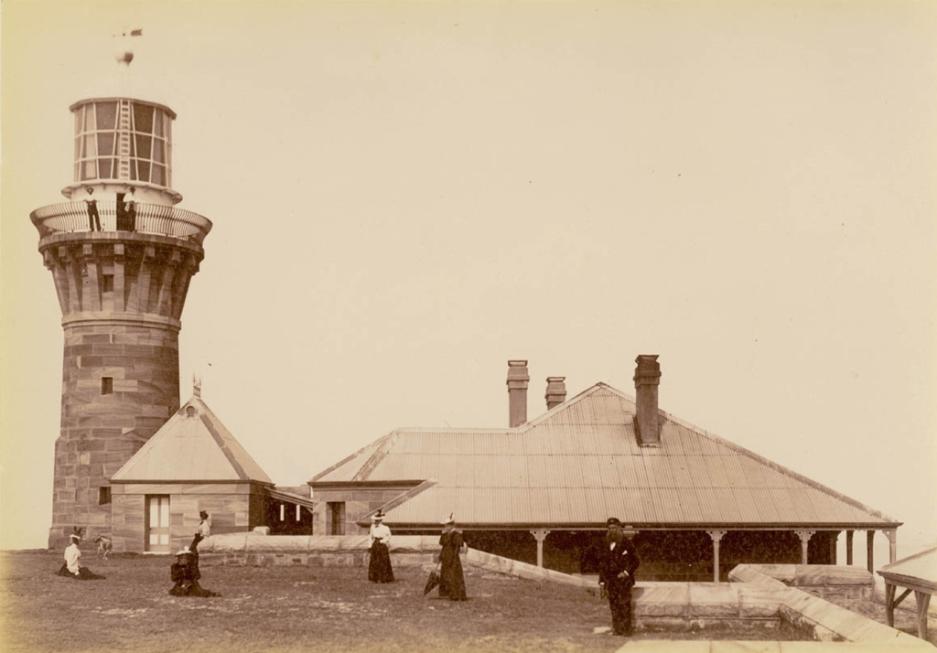
Barrenjoey Lighthouse, ca. 1900-1910, Image No: a116418, courtesy State Library of NSW; Mona Vale Library Image's state this is circa 1890 and Captain William Champion is gentleman to right of this sepia photo.
CHAMPION. —March 10, 1906, at Royal Prince Alfred Hospital, Captain William Henry Champion, late of Barrenjoey, Broken Bay, aged 71 years. Family Notices. (1906, March 12). The Sydney Morning Herald(NSW : 1842 - 1954), p. 6. Retrieved fromhttp://nla.gov.au/nla.news-article14758211
CHAMPION.-August 28, 1914, at the residence, Postoffice, Pymble, Eva Aldena (late Postmistress), widow of the late Captain W. H. Champion, H.M. Customs, Barranjoey, Broken Bay, and dearly beloved mother of Queenie and Nathalie Champion. At rest. Interment at Gordon Cemetery, Saturday, 29th, 11.30 a.m. Family Notices. (1914, August 29). The Sydney Morning Herald (NSW : 1842 - 1954), p. 12. Retrieved , from http://nla.gov.au/nla.news-article15533371
Further threads point to a Hawkesbury river association in Mr Frank Eckman, another Customs Station Officer of this last period. He married the daughter of a renowned captain. The Eckman's also lost a loved one at Barrenjoey;
ECKMAN. May 16, 1943, at her residence, 117 Douglas Street, Stockton, Newcastle, Frances Phelemina Eckman, daughter of the late Captain Peter and Sarah Melvey and beloved wife of the late Frank Eckman(late of the Customs), and mother of Melvey, Willie, Ernest, Ada, Zita, and Frank, aged 83 years. R.I.P. Family Notices. (1943, May 17). The Sydney Morning Herald(NSW : 1842 - 1954), p. 8. Retrieved from http://nla.gov.au/nla.news-article17848742
ECKMAN. On Monday, March 16, John Joseph, the youngest dearly beloved son of Frank and Frances Eckman, and grandson of Peter and Sarah Melvey, Hawkesbury River, accidentally drowned at Barrenjoey, aged 18 months. Family Notices. (1891, March 20). The Sydney Morning Herald(NSW : 1842 - 1954), p. 1. Retrieved from http://nla.gov.au/nla.news-article13818120
ECKMAN. —October 28, at his son-in-law's residence, 29 Douglas-street, Stockton, Frank Eckman, late of Customs, Barranjoey and Newcastle, dearly loved husband of Frances Eckman, and father of Melvey, William, Ernest, Frank, Ada and Zita, and son-in-law of the late Captain Melvey, of North Sydney, aged 72 years. Family Notices. (1925, October 30). The Sydney Morning Herald (NSW : 1842 - 1954), p. 10. Retrieved from http://nla.gov.au/nla.news-article16251639
Incidents in and around Barrenjoey During these early school years - perhaps not such a lonely place?
This is just a small sample of what was going on in and around Barrenjoey headland during the years these children had a school there and what they may have witnessed - worth thinking about:
CORONER'S COURT, THIS DAY
Captain Melville of the Schooner Caledonia
An inquest was held this morning, before the City Coroner, at the Lord Clyde Hotel, Pyrmont, on the body of Donald McLennan, alias Melville, who was drowned off Broken Bay on Friday last, through the capsizing of the schooner Caledonia, of which vessel he was the master. The body was brought to Sydney, yesterday, by the steamship Diamantina
Isabella McLennan: I reside at Point-Street, Pyrmont, and recognise the dead body just viewed at my residence, as that of my late husband, Donald McLennan. This name was his proper one; but he was generally known by the name of Donald Melville. He was fifty seven years of age, a native of Scotland, and a master mariner. He commanded the schooner Caledonia, which traded between Sydney and Port Stephens. On Wednesday night last, at about 9 o'clock, he left, home with the intention of going to sea. I saw no more of him till his dead body was brought home, yesterday, by constable Martin. Deceased has been in the colony about twenty-two years. We have been married sixteen years, and have one child. He (deceased) was a man of temperate habits, and has commanded the Caledonia for about five years. Peter Barry deposed: I am a mariner, and have been employed for the last three years as mate on board the schooner Caledonia. I recognise the dead body Just viewed by me as that of Captain Donald Melville, who was master of the schooner Caledonia. On last Friday morning we left Sydney, in ballast, bound for Port Stephens. There was about five tons of cargo on board. The crew consisted of the master, myself, and two other men. The tonnage of the vessel, which was a fore and aft schooner, was between 43 and 50 tons. Before we reached Broken Bay the weather was thick, squally, and rainy, and the deceased determined to run into Broken Bay for shelter. Between Barrenjoey light and the Custom-house station we had very little wind, being under the lee of the land. We were then close-hauled on the port tack, and we passed the Customs' station. The wind was then W.S.W., and the time about half past 11 a.m.While on the port tack, and reaching over for Soldiers' Creek, for anchorage, we attempted to put the vessel about on the other tack, when she was struck by a squall which split the inner jib and fore trysail - though the sails were in good condition. We then dropped anchor in about four fathoms of water. The anchor held on by very little chain. At this time the only sails set were the foresail and mainsail. Deceased, not thinking the position of the ship safe, (it being close to some rocks, and exposed to the squalls) directed the men to heave to the anchor short. I and the two other men went to the windlass to heave up the anchor; deceased, remaining at the tiller. After heaving short, the forestay sail and outer jib were set. The captain was still aft, and it was blowing strong in heavy puffs, with constant rain. I and the two men manned the windlass to heave the anchor, and had scarcely got it tripped from the bottom, when a squall struck the schooner (the wind being then about south) on the broadside. The vessel heeled over to port, and the anchor chains 'fetched over' to the same side. The vessel then went right over, turning bottom up. There were no reefs in the sails previous to this occurrence. I saw nothing more of deceased after the squall which struck the vessel till I saw him swimming, as I thought, for the shore. Two of us, the two seamen and myself, got on the vessel's side, and the other on the bottom, where we remained till we were taken off by a boat belong to another vessel lying in the bay. It was about forty or fifty yards from the shore where the vessel capsized. The body of deceased was recovered in about half an hour after the occurrence. He was quite dead. We never went to sea with more ballast (12. tons) than we had this voyage. The deceased and all hands were sober at the time of the occurrence. Charles Blatt, seaman, of the Caledonia on her last voyage, corroborated the evidence of the previous witnesses. The jury returned n verdict of accidental drowning in consequence of the capsizing of the schooner Caledonia. CORONER'S COURT, THIS DAY. (1872, October 7). Evening News (Sydney, NSW : 1869 - 1931), , p. 3. Retrieved from http://nla.gov.au/nla.news-article114733985
Peate's Ferry and Part of the Hawkesbury.
By "NOMAD."
Peate's Ferry is called Peate's Ferry because a party by the name of Peate used to ferry people across the Hawkesbury in the days when the Hawkesbury was the Hawkesbury before Sydney was born, to quote the Welsh, which is satisfactory nomenclature. A man once told me, on inquiry, that a piece was called Boolongoo-barribie, because a fight between the natives and the whites occurred there, so it is a comfort to know that we needn't bother much about the way in which Peate's Ferry achieved its designation. Everybody is, of course, acquainted with the configuration of the Australian coast, and it is only necessary for me to mention that on entering Broken Bay one finds three great sheets of diverging waters—the Broadwater ; with its confluents and affluents, at the head of which lies Gosford, to the right ; the Pitt Water ending in Newport on the way to Manly, on the left ; and the Hawkesbury River guarded by the crouching Lion Island straight ahead. Barrenjoey (Barrangewie, the poetic post, and every other thing else master wishes to have it pronounced in spite of the obvious fact that some prosaic old whaler on catching sight of the bald, sterile rock on which the lighthouse stands, sang out " Barren Joey,") is a great place. After leaving the Pacific and rounding the huge rock, one sails into a splendid bay where the jetty stands, where Mr. Black has his house. As I sail before Mr. Black is post and telegraph master, Customs officer for the Hawkesbury River, and holds a number of other offices, and only those who have enjoyed his princely hospitality, can form any idea of his generosity and the beauty of his principality. The settlement consists of Mr. Black's residence, a charmingly embowered dwelling, standing in the midst of a fine garden and grounds, and some few boatmen's cottages by the brown sand and the sea shore. The water is still and exquisitely blue, and the foliage luxuriant and plentiful. Up the Pitt-water there is fine arable land, well treed and grassed, and in time settlement will push over there from Manly. The lighthouse at Barrenjoey is up the hill on the bold promontory, and is quite out of sight; the climb to the edifice and surrounding buildings being tedious and difficult enough to deter the ordinary tourist. Leaving Barrenjoey, we proceed up the Hawkesbury…Peate's Ferry and Part of the Hawkesbury. (1884, August 4). Evening News (Sydney, NSW : 1869 - 1931), , p. 6. Retrieved from http://nla.gov.au/nla.news-article107262718
The yacht Red Gauntlet left Barrenjoey yesterday for Sydney in the company of a number of vessels which were there weather-bound. EXPORTS.—MARCH 23. (1885, March 24). The Sydney Morning Herald (NSW : 1842 - 1954), , p. 6. Retrieved from http://nla.gov.au/nla.news-article13582342
THE YACHT RED GAUNTLET.
Yachting in Victoria has made rapid strides within the past few years, and the Victoria Yacht Club numbers amongst its members several wealthy gentlemen,- who, imbued with a love of the amusement, have obtained vessels that would be a credit to any yacht club in the world. Prominent amongst the vessels to which we allude is the celebrated Red Gauntlet, a yacht owned by Messrs. C. and E. Millar, the elder of whom is commodore of the club. The Red Gauntlet was built at Lymington by Mr. Inman, a celebrated yacht builder, to the order of Mr. Haig, an English gentleman, who subsequently sold her to Mr. Langtry, the husband of the lady known in English society as the Jersey Lily. The yacht eventually fell into the hands of a Mr. Balfour,' who brought her out to the colony, and, he dying in Sydney, she fell into the hands of her present owners. The yacht is 148 tons register, her dimensions being 101 feet over all and 19 feet beam. She is rigged as a fore-and-aft schooner, and is a beautiful model, her lines being exceptionally fine, and she is a very fast vessel in a good breeze. The yacht is kept in beautiful order, and the visitor on stepping on board is struck by the neat appearance of everything on deck. Her cabin accommodation, though necessarily limited, is most complete, and the fittings are the perfection of good taste, and she is just what a gentleman's yacht should be.
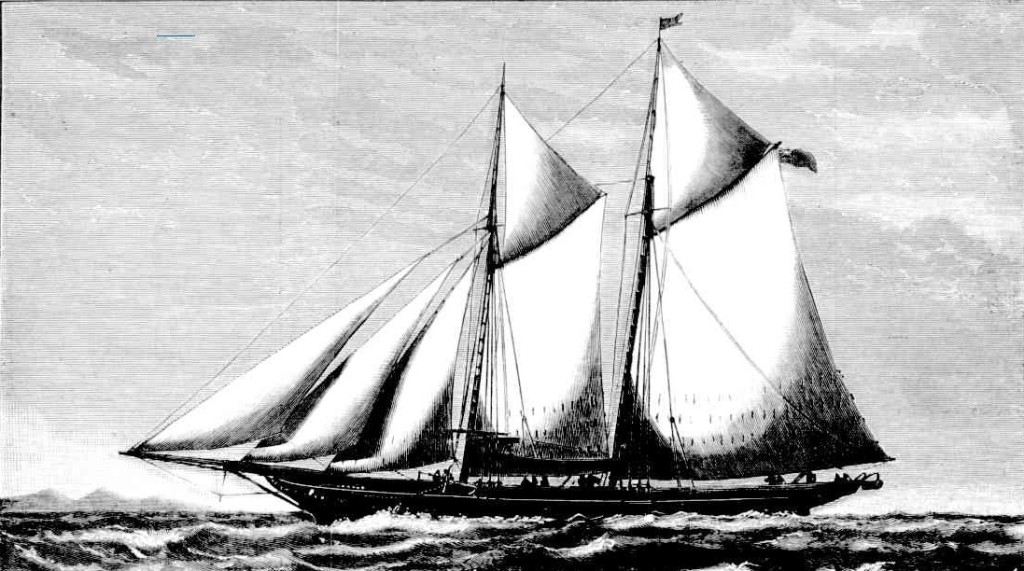
The Red Gauntlet was recently re-fitted in Melbourne her owners sparing no expense in making her all that could be desired, and when the work had been finished a party proceeded in her for a somewhat extended cruise. She left Melbourne on the 3rd January, and after paying a visit to several of the islands in. Bass's Straits, she proceeded to Hobart, where she arrived on the 11th January, and was very much admired by the nautical authorities of that place. After remaining there several days she returned to Melbourne, and on the voyage back encountered some exceptionally heavy weather, in 'which she proved herself to be a magnificent sea boat. The Red Gauntlet is not intended as a racer, but there can be no doubt that with her fine lines she would in a breeze of wind give a very good account of herself. With the exception of the steam yacht Cushie Doo, which is 358 tons, the Red Gauntlet is the largest vessel in the V. Y. C. fleet. THE YACHT RED GAUNTLET. (1882, March 22). Illustrated Australian News (Melbourne, Vic. : 1876 - 1889), p. 36. Retrieved from http://nla.gov.au/nla.news-article63186028
LOSS OF, CAPTAIN JOHNSON OFF BARRENJOEY [BY TELEGRAPH) (FROM OUR OWN CORRESPONDENT.)
BARRANJOEY, FRIDAY. Captain C. Johnston, of the steamer Albatross, fell over-board when the steamer was passing the bay to-day, enroute from Sydney to Gosford, and Was unfortunately drowned. It appears he could not swim, and although the steamer was stopped quickly as possible and sent astern, she was going so fast that it took some time to get back. In the meantime the unfortunate man, who was heavily clothed, was seen by several persons from the steamer struggling, and at last, he disappeared. The accident occurred about 11 a.m., and in the afternoon Mr. Rock Davis, of Blackwall, with his steamer, assisted by the Customs launch from Barrenjoey, made unsuccessful attempts to recover the body. It is extremely doubtful if it will be found, as the tides were running strongly when the accident occurred. Captain Johnston was much respected by they who have become acquainted with him since he his been running here, and great sympathy is expressed for his unfortunate widow and family. LOSS OF CAPTAIN JOHNSTON OFF BROKEN BAY. (1885, June 6). The Sydney Morning Herald (NSW : 1842 - 1954), , p. 7. Retrieved from http://nla.gov.au/nla.news-article28362227
Death of:
MULHALL.—June 25, Mr. George Mulhall, sen., lighthouse- keeper, of Barrenjoey, Broken Bay Family Notices (1885, June 30).The Sydney Morning Herald (NSW : 1842 - 1954), , p. 1. Retrieved from http://nla.gov.au/nla.news-article28362731
A Teacher's perspective of 'Bush Schools'
BUSH SCHOOLS. A SPECIAL SYSTEM.' FOR THE BUSH. SIXTEEN YEARS BUSH TEACHING.
[For The Worker.]
...'s assertion in The Worker (25/:i/'05) that 'it is best not to be a teacher in the country' is a solid truth, although it comes out of a sketch purposely exaggerated to draw attention to the hardships of the man sent bushward by the Education Department. Sixteen years of teaching spent almost entirely in the bush, and owing to that the fact that I was a teacher of the third generation, for my grandsire was one of the first teachers in N.S.W., ought to make my opinion of some weight. I. have taught in all classes of bush schools, and never see a bush teacher's complaint, such as that which appeared in Worker's ' Letter Box ' of tho above date, without thinking of my own experiences in a Department which knows nothing of the needs of the bush. At various times I have had charge of half-time, provisional, and small public schools, and therefore know something of their conditions. I have taught in a humpy— it was nothing better — in Inverell with the glass at 115 in the shade, and have attempted to leach in a hut, politely called a school, on Monaro when the mercury in the glass was trying to find its way out of the bottom. I was in the service when the pompous tiger-slaying Inglis was Minister of this most important department; tho individual who brought himself into unpleasant prominence by striking out the fuel and cleaning allowances granted lo schools; the empty-headed blatant politician — I suppose to-day he is anti-Socialist — who during tho winter months toasted his shins at the Government built fire in a luxurious office while the children of Monaro and kindred places tramped over tracks of frost and ice to shiver in a building the Minister had the effrontery to term a school. I was in the service when ' Barranjoey ' Carruthers was one of the creatures of a Parkes administration. Have you ever noticed - how 'a creature' of one individual invariably sits on the one beneath him? It was so will ' Barranjoey.' In his time a male teacher in charge of a third-class provisional school received the munificent salary of .£60 per annum, from which four per cent, was deducted to go to. the superannuation fund. The salary then passed out £'l 16s. per month. A deputation of bush teachers waited ou the Minister and pointed out to him tho hardships of their lot; how it was almost impossible to get lodgings, the selector's homes being too small to accommodate teachers; and how some of them were compelled to board at the ... shanties on the bush tracks. ' Barranjoey's ' unsympathetic reply was: ' I suppose they live there from choice.' If over a man deserved kicking it was Minister Carruthers on that occasion. At that time I was drawing the glorious salary of -£60 .per annum, less the four per cent., which, with permission of the Editor, I may have something further to say about. Fancy a man drawing that fat wage living in a wine shanty from choice! Fancy — if you can— the riotous living lie could indulge in. ' Barranjoey ' knew as much about shanties as he knew of the Department over which he presided. Reared in an educational atmosphere I was led to believe that the Education Act of 1880— for which the late Sir Henry Parkes wrongly received much credit — was the grandest in tho world, and our bush schools ' tho observed of all observers.' Yet in tho nineties I taught in a hut — called a- school — where in the winter time I had lo break up ant-beds to make mortar lo fill up t he cracks between tho slabs to keep out the bleak winds that swept over Monaro's snow-capped ranges. I have attempted to teach in schools where the Department refused to supply a map, and the material was of the scantiest description. In 0110 school in central N.S.W. there was no water nearer than two miles, and that was brackish. Yet children carried it in bottles to school, and often ... ill on a hot summer's day Little children had either to be let go home or swelter in a galvanized iron building without even brackish water to cool their parched lips. I often let them go home rather than see them suffer. It took two years' constant writing before I persuaded them to send a four hundred gallon tank. I never know how niggardly bush schools were treated in N.S.W. till I went West in 1896, and found in the so-called G roper-land a system which was a credit to Sunny Australia. ... all the Westralian bush schools I served in I found nothing in the shape of cheese-paring. Children of people who were out 011 the building up tho future wealth of the State were not treated as if they were the offsprings of serfs and a future race of slaves themselves. All that the city schools had in tho way of material and comfort was extended to the neat little buildings that truly wore schools in tho bush It was in Westralia where I first heard the truth uttered by the newly imported Director of Education, Cyril Jackson, who after visiting every school in the State said: 'It is plain to me that the conditions of the bush need an entirely different system from that of the town.' And who will say that this is not true? A different system, but none tho less thorough, and the future men and women of tho bush will not be the hard, sombre figures Lawson and other pessimistic writers love to portray. HUGH STONE. BUSH SCHOOLS. (1905, April 8). The Worker (Wagga, NSW : 1892 - 1913), , p. 10. Retrieved from http://nla.gov.au/nla.news-article145731234
IMPORTANT TO STOCKOWNERS. — A case of some interest to stockowners, which serves to show how far the cattle-stealing prevention act goes in protecting their rights, recently came before the water police court, Sydney. Under the third section of that act, John Farrell, licensee of the Colonnade Hotel, Manly Beach, was summoned by Thomas Albert Black, customs officer at Barrenjoey, with having illegally used a certain Devon bull between the 8th and 22nd days of September last. The case against the defendant was that he was seen driving the bull away from its pasture grounds together with two cows, and that subsequently the animal was seen in a securely-fenced paddock belonging to Farrell, at his farm, two miles distant, herding with some cows. The defence was that the bull had trespassed if it had been in the paddock, as it was very clever at getting over fences or through them, if they were at all out of repair. On defendant's behalf, it was denied that he had ever driven the bull home as alleged, and that even if he had done so he did not intend to illegally use it, as the animal was valueless at the stud. For complainant, Mr. W. Roberts sen., (who with Messrs. Merriman and Carroll were retained to prosecute), urged that the case was a gross one, and that it behoved the magistrates to use their authority to protect the stock of settlers in isolated places by sending defendant to gaol under the penal provisions of the clause, which gave their worships power to inflict a sentence of twelve months' imprisonment, or a fine of £20. The magistrates held the case proved, and fined Farrell £10, with £3 3/- professional costs, to be levied by distress in default of payment, failing which two months' imprisonment. He was defended by Messrs. Clayton and Lowe, who asked the court to allow the costs to be paid out of the fine, but the request was refused. ST. SAVIOUR'S DAY-SCHOOL. (1881, January 19). The Goulburn Herald and Chronicle (NSW : 1864 - 1881), p. 2. Retrieved from http://nla.gov.au/nla.news-article103812500
EARLY PITTWATER The present church standing on a different site on the other side of Pitt Street Is by this time a famous and popular place of worship. Ferries now ply from various parts of the Hawkesbury to Newport and other places, but in the early days the whole of the traffic to Pittwater was carried through Newport. Bayview and Church Point, as we now know then did not exist, and pathways through farms were in use. The late Mrs. Maybanke Anderson, in her story of Pittwater, depicts the progress made: 'As time went on Bayview became more settled than Newport, and passengers from Manly were transferred at Rock Lily to a smaller coach, while the larger one carried the majority to Bayview and Church Point.' In the years that followed, Newport overtook Bayview. Bayview remaining as the residents devoutly wished. 'a quiet very distant suburb.' As regards the first Mass held in Sydney. Mr. Bertie relates: 'The site , of the Strand Picture Theatres has a claim for recognition by Catholic members of the community. . . . The ' site is shown on Meehan's map as a lease to Captain John Houston. On May 6. 1807. the captain sold to John Reddington the property on which was erected a house (who. however, was not then alive, as he died In October of 1816) that the Fathers Conolly and Therry held their first Mass In Sydney, in May. 1820. and It was here that Father Therry held a ceremony on May 7. 1823. In a temporary chapel. The house Mr. Welngarth states, stood partly on the sites of the Strand and Her Majesty's Theatres.' The first boat appears to have been built and launched In Sydney Harbor in 1789 but only for harbor use. She was built for the Rose Hill farmers' convenience, and was so ugly that she got to be known as 'The Lump.' Officially she was known as the Rose Hill Packet. Pittwater started early to add to the shipbuilding. Many sloops and vessels were built at this beautiful spot. Mr. Stokes built several. He gave his name to Stoke Point more often called Stripe Point, south of Careel Bay. A man called Bradbury is credited with having built the first boats at Careel Bay. George Green, father of the sculler, built and launched a vessel in 1855. on the east side of Clareville between Stokes Point and Taylor's Point. It was on the stretch of water at the head of Pittwater that Green's son— Dick trained for the championships. MILESTONES IN EARLY COLONIAL PROGRESS (1941, February 8). The Newcastle Sun (NSW : 1918 - 1954), , p. 4. Retrieved from http://nla.gov.au/nla.news-article167440508
A sailor named Charles Nicholson, a Swede, was arrested at Barranjoey, on Tuesday evening last, charged with having stolen a boat belonging to Mr. Webster, of Berry's Bay, North Shore. The circumstances of the case are of a peculiar nature. It appears that Nicholson wanted to get to Newcastle, and not having the wherewithal! to pay his .fare, he took the boat — an ordinary waterman's craft — in which he set on his perilous voyage on Monday night without either food or water, and nothing in the way of boat's gear with the exception of a pair of sculls. He was totally unacquainted with the coast, and, by the merest chance, he ran into Broken Bay in order to procure some water. A resident of Barranjoey having seen the man, suspected that there was something wrong, and at once telegraphed to the authorities in Sydney, the result being that a constable was sent up and the man was arrested. MOND. TUESD. WED. THURS. FRID. SAT. SUND THE WEEK (1886, January 30). The Sydney Mail and New South Wales Advertiser (NSW : 1871 - 1912), , p. 245. Retrieved from http://nla.gov.au/nla.news-article162816871
"ALBATROSS" Will run as above, leaving Churchill's Wharf, at 7-.4-1 a.m. The Steamer will pick up passengers on her way down the river, and arrive at Gosford about 4 p.m. On the following morning the Steamer leaves Gosford at 7, and will land passengers who desire a few hours on the sea-shore, or wish to visit the Light-house, at Barrenjoey, while the " Albatross" proceeds to sea for a couple of hours schnapper fishing. Bait supplied. Hooks and lines may be obtained on board. An experienced Stewardess will accompany the Steamer.. ! FARES : RETURN, 5s. A. MANNING. Advertising (1886, April 3). Hawkesbury Chronicle and Farmers Advocate (Windsor, NSW : 1881 - 1888), , p. 3. Retrieved from http://nla.gov.au/nla.news-article66373139
The Race Between tlie 'Waitangi and Electra.
TO THE EDITOR OF THE SYDNEY ...
Sir, — I have just read in this week's issue of your paper the amusing and well-written article headed 'Sailing Notes,' by the Ancient Mariner. The yarns spun by the worthy old salt, though somewhat tough, are usually very agreeable to his readers, and must no doubt afford him as great pleasure in their concoction as we derive from their perusal. In this article is an account of the race which took place on the 13th instant under the auspices of the P. A. Y. C., between the Waitangi and the Electra. It abounds in happy nautical allusions and pleasant descriptions, yet it has one fault — the greater portion is incorrect, and one egregious ems' is present, which causes me to write this note.
In this account the crew of the Electra are described as having been very dissatisfied when they found that the inside course was substituted for the original published one, which required the competing yachts to go round a boat moored off Curl Curl. The next lays down the axiom that, ' the sea being too rough to allow the mooring of the boat at the indicated spot, the steamer chartered by the dub for the members and their friends should do duty as the absent mark.' This is a reduetio adsurdum, as in my opinion an ordinary 24-foot open fisherman's boat is a much better sea boat than an ordinary steam-launch of 100. The little Geebung, our dearl steamer, did her best, and her utmost powers could only have enabled her to follow the race. To have asked her to anchor, under the circumstances, in the open sea, encumbered with her top-hamper and crowd of passengers, might have meant swamping and loss of life. With .such a force of wind and sea as existed on this occasion, it would have been absurd to have used a vessel as a mark without anchoring, since it would have been impossible to have kept it stationary. This matter of using the steamboat as a mark was tried on one occasion about three oc- four years, ago, if I recollect rightly, in a race between the Oithona and the Waitangi, when considerable dissatisfaction followed. It was said that one of the competing yachts went nearly a mile further down the coast to round the steamer than die other — in this case, of course, the steamer did not anchor. As commodore of the day I thought, and think still, that there was quite sufficient reason why the outside coarse should have been abandoned and the inside one substituted. I wonder how the ladies on board our Geebung would have fared I adopted similar views to our ancient friend, and sent the pleasure party to sea. There was some trouble on board as it was as the little steamer traversed the broken water between the lightship and Manly. One medical gentleman, whose usual aspect might be taken for a model for a statue of Health, collapsed and assumed a greeny tint, while several ladies also owned to the depressing powers of Neptune. I am also in this article accused of improperly starting ' the yachts, allowing eight minutes to pass, instead of fife, between raising and depressing the ensign. The ' Ancient Mariner ' does not state this from his own knowledge, but from information supplied to him by the timekeeper on board the Electra; yet he entirely adopts this gentleman's views, and acting upon them accuses me either of something very like gross negligence and incompetency or conduct which can hardly be described as honourable. In answer to this — and this is the chief reason that I have written to you — I must tell you that I drew my watch out of its pocket (it is provided with a large second hand), held it in my hand, and at 1h. 58min. 30sec. told my lads to fire the gun and hoist the ensign. Holding the watch still in my hand, at 2h. 1min, 30sec., I told my to crew fire the second gun, and lower the ensign, and this was done promptly to the second. Twice I have been accused of this same thing on this occasion; once in the pages of your own influential periodical and in those of another journal. I think those who know me least will in this case condemn me most. The honorary secretary of the club, the reporters of the daily papers, and some of the ladies and gentlemen on board the steamer saw. the incidents of the start, and will bear me out in the correctness of what I state. In the approaching trip to Jervis Bay I hope to often have the pleasure of listening to the amusing yarns spun by our ancient friend, and I promise to stretch my credulity to the utmost limits should I hear anecdotes even of the inner life of a shark 40 feet long, or a description of a run down to Barrenjoey and beat back against a southerly ' buster' in 12 hours, in a 14-feet dingy. Taking into consideration, however, this tale of the interval between the guns, I am afraid I must take all such stories cum grano salts. — I am, &c., THE STARTER. Sydney, February 20, 1886. The Race Between the Waitangi and Electra. (1886, February 27). The Sydney Mail and New South Wales Advertiser (NSW : 1871 - 1912), , p. 449. Retrieved from http://nla.gov.au/nla.news-article162811209
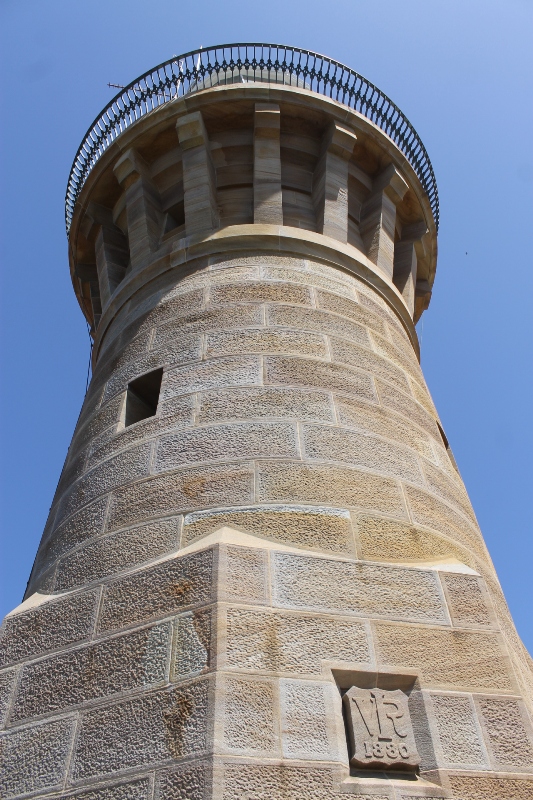 OCEAN YACHT RACE.
OCEAN YACHT RACE. 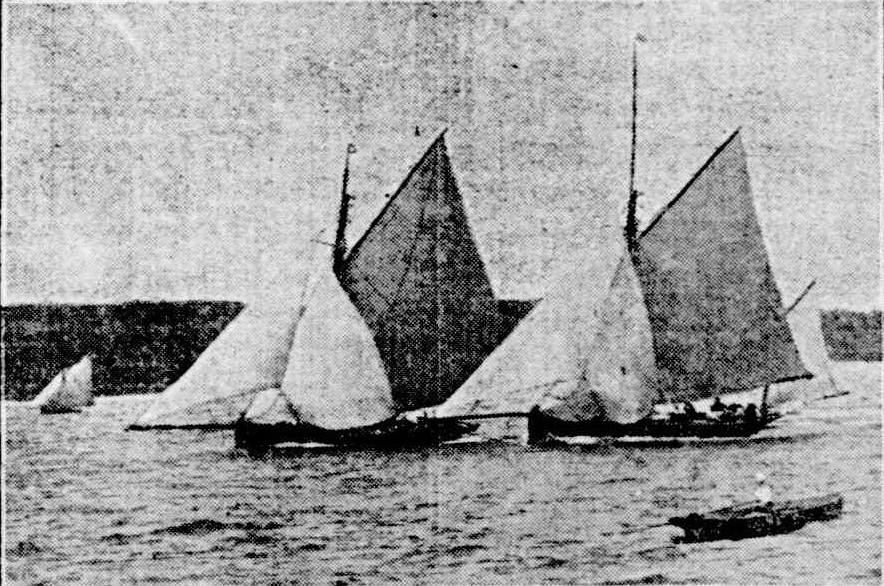
The Barrenjoey School 1872 to 1894 - threads collected and collated by A J Guesdon, 2016.